蝙蝠是手翅目(Chiroptera)哺乳动物; [a]其前肢适合作为翅膀,它们是唯一能够真实和持续飞行的哺乳动物。蝙蝠比鸟类更容易操纵,它们的超长伸展手指覆盖着薄膜或巴塔哥虫卵。最小的蝙蝠,也可以说是现存的最小的哺乳动物,是基蒂的猪鼻蝙蝠,它的长29-34毫米(1.14-1.34英寸),两翼长15厘米(5.91英寸),2-2.6克(0.07-英寸)。 0.09盎司)。最大的蝙蝠是果蝠和巨型金冠果蝠,其重达1.6千克(4磅),翼展为1.7 m(5英尺7英寸)。
蝙蝠是仅次于啮齿动物的第二大哺乳动物,蝙蝠约占全世界所有分类哺乳动物物种的20%,超过1,200种。传统上将它们分为两个子阶:主要是吃水果的巨型蝙蝠和回声定位微型蝙蝠。但是,最近的证据支持将the翅目分为Yin翅目和Yang翅目,其中大型蝙蝠是前翅目的成员,还有几种微型蝙蝠。许多蝙蝠是食虫动物,其余大多数是食肉动物(食水果者)。少数物种以昆虫以外的动物为食;例如,吸血蝙蝠以血液为食。大多数蝙蝠是夜行性的,许多栖于洞穴或其他避难所中。蝙蝠是否具有逃避捕食者的这些行为尚不确定。蝙蝠遍布世界各地,极寒地区除外。它们在其生态系统中对于授粉花朵和散布种子很重要;许多热带植物完全依靠蝙蝠提供这些服务。
蝙蝠以牺牲一些威胁为代价,为人类带来了一些好处。蝙蝠粪已从山洞中作为鸟粪被开采并用作肥料。蝙蝠食用害虫,减少了对农药的需求。它们有时数量众多,足以作为旅游胜地,并在整个亚洲和环太平洋地区被用作食品。它们是狂犬病等许多病原体的天然库;而且由于它们具有高度的流动性,社交性和寿命长,因此可以很容易地传播疾病。在许多文化中,蝙蝠通常与黑暗,恶意,巫术,吸血鬼和死亡相关。
内容
1 词源
2 系统发育与分类
2.1 演变
2.2 分类
3 解剖生理学
3.1 头骨和牙列
3.2 机翼与飞行
3.3 栖息和步态
3.4 内部系统
3.5 感官
3.5.1 回声
3.5.2 愿景
3.5.3 磁感受
3.6 温度调节
3.6.1 迟钝
3.7 大小
4 生态学
4.1 食物和喂养
4.1.1 昆虫
4.1.2 水果和花蜜
4.1.3 脊椎动物
4.1.4 血液
4.2 捕食者,寄生虫和疾病
5 社会行为
5.1 社会结构
5.2 沟通
6 生殖和生活史
6.1 策略
6.2 配合
6.3 生命周期
6.4 预期寿命
7 与人类的互动
7.1 保护
7.2 文化意义
7.3 经济学
8 参见
词源
蝙蝠的较早英文名称是flittermouse,与其他日耳曼语(例如,德国Fledermaus和瑞典fladdermus)的名称相称,与翅膀的颤动有关。中古英语有bakke,最有可能与古瑞典natbakka(“ night-bat”)同源,在拉丁语blatta的影响下,该词可能已从-k-转换为-t-(至现代英语的蝙蝠),“飞蛾,夜间昆虫” ”。 “蝙蝠”一词可能最早是在1570年代初期使用的。[2] [3] “鳞翅目”的名称源自古希腊语:χε**ρ–唱诗班,“手” [4]和πτερ**ν–翼龙,“翅膀”。[1] [5]
系统发育和分类学
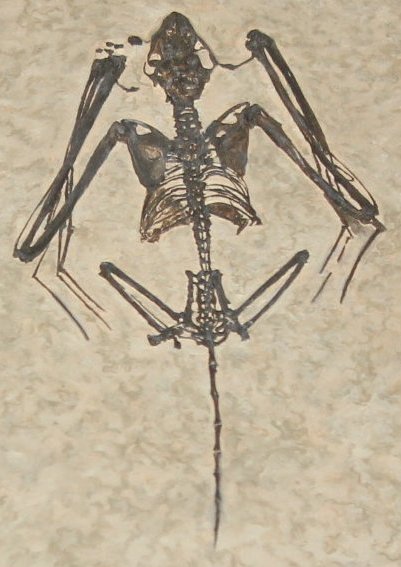
早始新世化石小翼龙,来自绿河组
演化
蝙蝠的精致骨架化石不好,据估计,化石记录中仅发现了生活的蝙蝠属的12%。[6]大多数已知最古老的蝙蝠化石已经与现代微型蝙蝠非常相似,例如始祖鸟(3200万年前)。[7]灭绝的蝙蝠Palaeochiropteryx tupaiodon(4800万年前)和Hassianycteris kumari(5500万年前)是发现其颜色的第一批化石哺乳动物:均为红棕色。[8] [9]
蝙蝠先前与树h(Scandentia),colugos(Dermoptera)和灵长类动物一起被分组在上级Archonta中。[10]现在,现代遗传学证据将蝙蝠置于其上等分类群Fereuungulata的超阶Laurasiatheria中,其中包括食肉动物,穿山甲,奇数有蹄类动物,偶数有蹄类动物和鲸类动物。[11] [12] [13] [14] [ 15]一项研究将翼手目作为奇类有蹄类动物(Perissodactyla)的姊妹分类。[16]
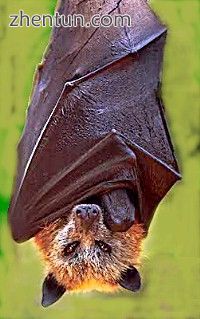
巨型金冠果蝇狐猴
在1980年代,基于形态学证据的假设表明,巨翅目与微型翅目是分开飞行的。飞行中的灵长类动物假说提出,当去除对飞行的适应性时,大型手足类动物会通过与小手足类动物不共有的解剖特征而与灵长类动物结盟。例如,巨型蝙蝠的大脑具有先进的特征。尽管最近的遗传学研究强烈支持蝙蝠的单性,[7]仍在争论遗传和形态学证据的含义。[19]
2003年从5200万年前的绿河形成中发现了早期的化石蝙蝠,即Onychonycteris finneyi,这表明飞行是在回声定位能力之前演化的。[20] [21] Onychonycteris的五个手指上都有爪子,而现代蝙蝠每只手的两位数上最多有两个爪子。它的后腿也更长,前臂也更短,类似于悬挂在树枝下的攀爬哺乳动物,例如树懒和长臂猿。这只棕榈大小的蝙蝠翅膀短而宽,这表明它不可能飞得很快或远不及后来的蝙蝠种类。在飞行过程中,Onychonycteris可能会在皮瓣和滑行之间交替飞行,而不是在飞行过程中不断拍打翅膀。[7]这表明这只蝙蝠的飞行速度不如现代蝙蝠,而是从树上飞到树上,并花费了大部分时间攀爬或悬挂在树枝上。[22] Onychonycteris化石的独特特征还支持以下假设:哺乳动物的飞行最有可能在树状运动动物而不是陆生赛跑者中进化。这种飞行发展模型,通常被称为“落树”理论,认为蝙蝠通过利用高度和重力落入猎物而不是跑得足够快以至于在地面上起飞而首先飞行。 23] [24]
分子系统发育是有争议的,因为它指出微蝙蝠没有独特的共同血统,这意味着发生了一些看似不可能的转化。首先是喉回声定位在蝙蝠中进化了两次,一次在Yangochiroptera中,一次在鼻虫中[25]。第二个原因是喉回声定位起源于翼手目,随后在翼足科(所有巨型蝙蝠)中消失,后来在Rousettus属中成为舌头单击系统。[26]关于发声基因FoxP2序列的分析对于在翼足类中是否丢失了喉部回声定位或在回声定位谱系中获得了喉回声定位尚无定论。[27]回声定位最早可能是蝙蝠从交际中获得的。始新世蝙蝠Icaronycteris(5200万年前)和Palaiochiropteryx具有颅骨适应性,提示可以检测超声波。最初,这可能主要用于在地面上觅食昆虫,并在滑行阶段绘制出其周围环境或用于交流目的。建立飞行适应之后,可以通过回声定位将其精炼为目标飞行猎物。[22]蝙蝠可能已经通过一个共同的祖先进化出了回声定位,在这种情况下,蝙蝠便在旧世界的巨型蝙蝠中丢失了,只在马蹄蝙蝠中重新获得了回声。或者,回声定位在隐翅类和羊翅类谱系中独立发生。[28]对听力基因快蛋白的分析似乎支持这样一种观点,即回声定位至少独立发展两次,而不是在翼足类动物中继发性丢失; [29]但是耳蜗的本体分析表明,喉头回声定位仅进化了一次。[30]
分类
蝙蝠是胎盘哺乳动物。在啮齿动物之后,它们是最大的物种,约占哺乳动物物种的20%。[31] 1758年,卡尔·林奈(Carl Linnaeus)按照灵长类动物的分类将他所知道的7种蝙蝠物种归入Vespertilio属。大约二十年后,德国博物学家约翰·弗里德里希·布鲁门巴赫(Johann Friedrich B内腔bach)向他们发出了自己的订单Chiroptera。[32]自那时以来,所描述物种的数量已增加到1200多个,传统上被分为两个亚目:巨翅目(megabatroptera)和微翅目(Microchiroptera)(microbats / echolocating bats)。[33]并非所有的巨型蝙蝠都比微型蝙蝠大。[34]这两个组有几个特征。微型蝙蝠利用回声定位来导航和寻找猎物,但是除了Rousettus属之外的微型蝙蝠并不依赖它们,而是依靠它们的视力。[35]因此,巨型蝙蝠具有发达的视觉皮层和良好的视敏度。[33]巨型蝙蝠在前肢的食指上有一个爪子。[36] [37]微型蝙蝠的外耳不会闭合而形成环。边缘在耳朵的根部彼此分开。[37]巨型蝙蝠吃水果,花蜜或花粉,而大多数微型蝙蝠吃昆虫。其他人则以水果,花蜜,花粉,鱼,青蛙,小型哺乳动物或血液为食。[33]
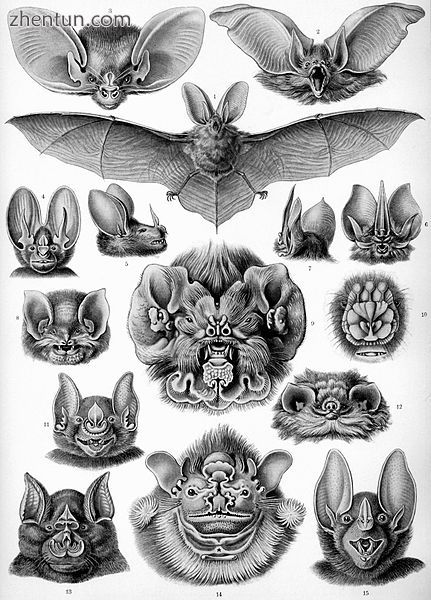
恩斯特·海克尔(Ernst Haeckel)的自然艺术博物馆(Kunstformen der Natur)的“鳞翅目”
解剖生理学
头骨和牙列
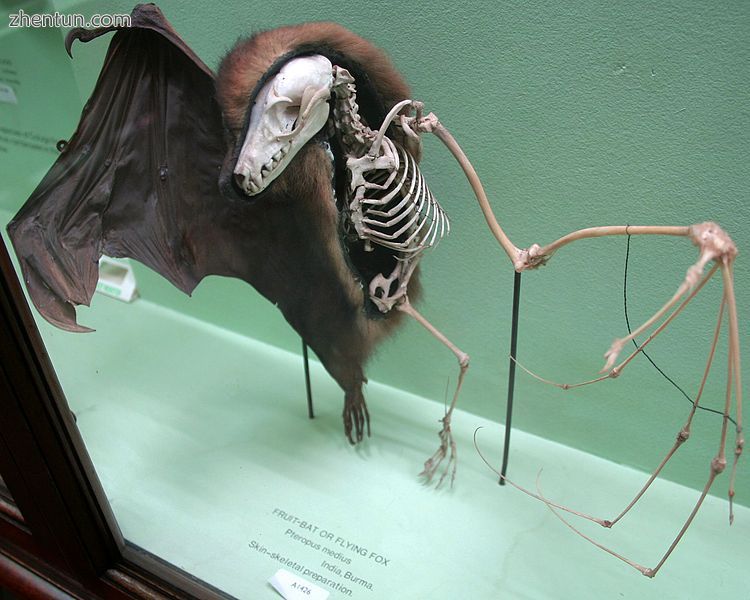
保存完好的megabat,显示骨骼如何贴合皮肤
蝙蝠的头部和牙齿的形状可能因物种而异。总的来说,巨型蝙蝠的鼻子长,眼窝大,耳朵小,使它们看起来更像狗,这就是它们绰号“飞狐”的源头。[39]在微型蝙蝠中,更长的鼻子与花蜜喂养有关。[40]而吸血蝙蝠减少了鼻子,以容纳大型门牙和犬齿。[41]
小型食虫蝙蝠最多可有38颗牙齿,而吸血蝙蝠只有20颗。以硬壳昆虫为食的蝙蝠与食肉性较弱的昆虫相比,齿数更少,但齿更大,犬齿更长,下颌更健壮。在采食花蜜的蝙蝠中,犬齿很长,而颊齿却很短。在吃水果的蝙蝠中,脸颊牙齿的尖端适合压碎。[40]这些喂食行为对于大型蝙蝠和微型蝙蝠都是正确的。吸血蝙蝠的上门齿缺少珐琅质,这使它们变得锋利无比。[41]小蝙蝠的咬力是通过机械优势产生的,使它们能够通过坚硬的昆虫盔甲或果皮进行叮咬。[42]
机翼与飞行
蝙蝠是唯一能够持续飞行而不是像松鼠那样滑动的哺乳动物。[43]最快的蝙蝠是墨西哥的无尾蝙蝠(Tadarida brasiliensis),可以达到每小时160公里(99 mph)的地面速度。[44]
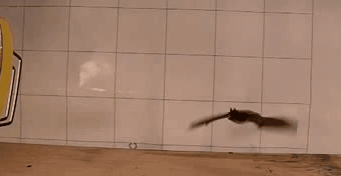
小棕蝙蝠起飞并飞行
由于其扁平的横截面和尖端附近的钙含量低,蝙蝠的指骨比其他哺乳动物的指骨更具柔韧性。蝙蝠手指的伸长是机翼发育所必需的关键特征,这是由于骨形态发生蛋白(Bmps)的上调所致。在胚胎发育过程中,控制Bmp信号传导的基因Bmp2在蝙蝠前肢中的表达增加,从而导致了人工手指的延伸。这种至关重要的遗传改变有助于创造动力飞行所需的特殊肢体。现存的蝙蝠前肢数字相对于始新世化石蝙蝠的相对比例无显著差异,这表明蝙蝠翼形态已经保存了超过五千万年。[45]在飞行过程中,骨骼受到弯曲和剪切应力。与陆地哺乳动物相比,感受到的弯曲应力较小,但剪切应力较大。蝙蝠的翼骨断裂应力要比鸟类的稍低。[46]
与其他哺乳动物一样,与鸟类不同,the骨是前臂的主要组成部分。蝙蝠有五个细长的手指,它们都散布在手腕上。拇指指向前方并支撑机翼的前缘,其他手指支撑保持在机翼膜上的张力。第二个和第三个手指沿着翼尖移动,使翼克服空气阻力而向前拉,而不必像翼龙一样厚。第四和第五个数字从手腕到后缘,并排斥空气向上推向坚硬的膜所引起的弯曲力。[47]由于它们的关节灵活,与滑行哺乳动物相比,蝙蝠具有更大的操纵性和灵活性。[48]
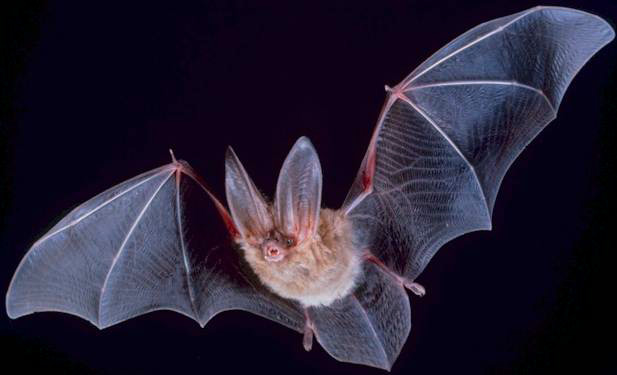
汤森(Townsend)大耳蝙蝠(Corynorhinus townsendii)的翼膜(patagia)[49]
蝙蝠的翅膀比鸟类的翅膀薄得多,并且骨骼更多,从而使蝙蝠比后者更准确地操纵,并以更大的升力和更少的阻力飞行。[49]通过在向上冲程中将机翼向自己的身体折叠,它们可以在飞行过程中节省35%的能量。[50]膜很脆弱,容易撕裂,[51]但可以长大,小的眼泪可以很快愈合。[51] [52]机翼表面在称为“默克尔”细胞的小突起上配备了触敏感受器,也可以在人的指尖上找到。这些蝙蝠的敏感区域不同,因为每个颠簸的中心都有一头细毛,使其变得更加敏感,并使蝙蝠能够检测并适应不断变化的气流。最主要的用途是判断飞行的最有效速度,并可能避免失速。[53]食虫蝙蝠也可能会使用触觉毛来帮助进行复杂的动作,以捕获飞行中的猎物。[48]
tag是机翼膜。它在手臂和手指的骨头之间伸展,从身体的一侧一直延伸到后肢和尾巴。这种皮肤膜由结缔组织,弹性纤维,神经,肌肉和血管组成。肌肉在飞行过程中使膜绷紧。[54]蝙蝠的尾巴附着在巴塔古堡上的程度因物种而异,其中有些尾巴完全自由,甚至没有尾巴。[40]蝙蝠身上的皮肤具有一层表皮和真皮,以及毛囊,汗腺和脂肪性皮下层,与机翼膜的皮肤有很大不同。 tag是表皮的极薄的双层。这些层被结缔组织中心隔开,结缔组织中心富含胶原蛋白和弹性纤维。除了手指之间,该膜没有毛囊或汗腺。[53] [55]对于蝙蝠胚胎,凋亡(细胞死亡)仅影响后肢,而前肢则保留形成翼膜的指趾之间的织带。[56]与坚硬的翅膀向肩膀传递弯曲和扭转应力的鸟类不同,蝙蝠具有仅能抵抗拉力的柔性翼膜。为了实现飞行,蝙蝠在膜与骨架相遇的点处向内施加力,从而使相反的力在垂直于机翼表面的机翼边缘上使之平衡。与鸟类不同,这种适应不允许蝙蝠减小其翼展,而鸟类可以在飞行中部分折叠其翼,从根本上减小了上翼和滑行的翼展和面积。因此,蝙蝠无法像鸟类一样长距离行走。[47]
吃花蜜和花粉的蝙蝠可以盘旋,类似于蜂鸟。机翼的锋利前缘会产生涡流,从而产生升力。动物可以通过改变翅膀的曲率来稳定漩涡。[57]
栖息和步态
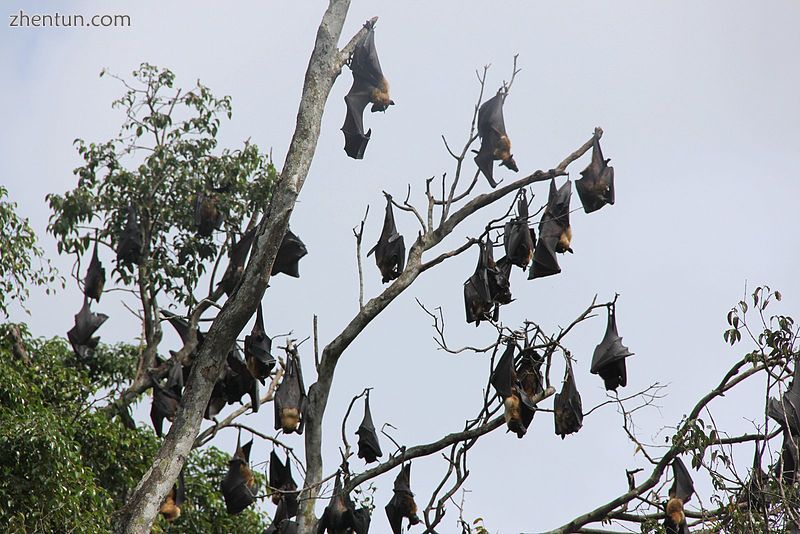
一群巨蝙蝠栖息
蝙蝠不飞时,蝙蝠会倒挂在脚上,这种姿势称为栖息。[58]股骨以使它们在飞行中向上和向外弯曲的方式连接在臀部。踝关节可以弯曲以允许翼的后缘向下弯曲。除了悬挂或攀爬树木之外,这不允许进行许多移动。[47]大多数巨型蝙蝠的头朝向腹部而栖息,而大多数微型蝙蝠的脖子向后弯曲而栖息。这种差异反映在两组的颈椎或颈部椎骨结构上,两者明显不同。[58]肌腱允许蝙蝠从栖息处垂下时将脚锁定为闭合状态。需要肌肉力量,但不要握住栖息处或握住它。[59]
在地面上时,大多数蝙蝠只能笨拙地爬行。少数物种,例如新西兰短尾蝙蝠和普通吸血蝙蝠,在地面上都很敏捷。这两种物种在缓慢移动时都会产生侧向步态(四肢一个接一个地运动),但是吸血蝙蝠以有限的步态运动(所有四肢一致地运动),折叠后的机翼用来推动它们向前移动。吸血蝙蝠可能进化了这些步态以跟随其宿主,而短尾蝙蝠则在没有陆地哺乳动物竞争者的情况下发展。增强的陆地运动似乎并未降低其飞行能力。[60]
内部系统
蝙蝠具有高效的循环系统。他们似乎利用了特别强劲的静脉运动,即静脉壁肌肉的节律性收缩。在大多数哺乳动物中,静脉壁主要提供被动阻力,在脱氧的血液流过它们时保持其形状,但在蝙蝠中,它们似乎通过这种泵送作用积极地支持血液流回心脏。[61] [62]由于蝙蝠的身体相对较小,重量较轻,因此在栖息时,蝙蝠没有冒着冲向头部的血流的危险。[63]
蝙蝠具有高度适应的呼吸系统,可以应付动力飞行的需求,这是一项精力充沛的活动,需要大量连续的氧气通过。在蝙蝠中,相对的肺泡表面积和肺毛细血管血容量比大多数其他小型四足哺乳动物更大。[64]在飞行过程中,呼吸周期与机翼节拍周期具有一一对应的关系。[65]由于哺乳动物肺部的约束,蝙蝠无法维持高空飞行。[47]
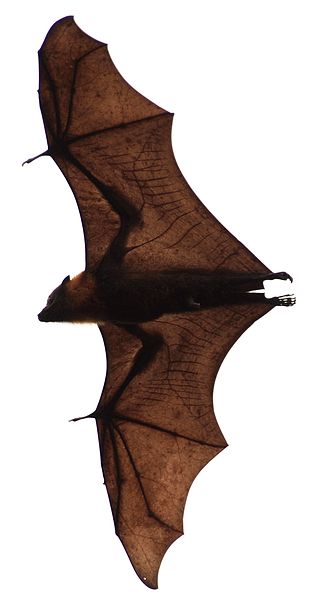
机翼是高度血管化的膜,在光线下可见较大的血管。[66]
蝙蝠的飞行肌肉需要大量的能量和有效的循环系统。与不将飞行作为哺乳动物运动手段的肌肉相比,飞行中的肌肉所需要的能量大约是其两倍。与能源消耗并行的是,飞行动物的血氧水平是其陆上活动哺乳动物的两倍。由于血液供应控制着整个身体的氧气供应量,因此循环系统必须做出相应的反应。因此,与相对大小相同的陆生哺乳动物相比,蝙蝠的心脏可以大三倍,并可以抽出更多的血液。[67]心输出量直接来自心率和血液的搏动量; [68]活跃的微型蝙蝠可以达到每分钟1000次心跳的心率。[69]
蝙蝠的翅膀的膜组织非常薄,可以极大地促进生物体的总气体交换效率。[55]由于飞行对能量的需求很高,蝙蝠的身体通过机翼的前襟交换气体来满足这些需求。当蝙蝠展开翅膀时,可以增加表面积与体积之比。机翼的表面积约为人体总表面积的85%,这表明可能进行有用程度的气体交换。[55]膜中的皮下血管非常靠近表面,并允许氧气和二氧化碳扩散。[70]
蝙蝠的消化系统具有不同的适应能力,具体取决于蝙蝠的种类及其饮食。与其他飞行动物一样,食物也可以快速有效地加工以适应能源需求。食虫蝙蝠可能具有某些消化酶来更好地处理昆虫,例如几丁质酶可以分解几丁质,而几丁质是昆虫的重要组成部分。[71]吸血蝙蝠,可能是由于他们的饮食所致,是仅有的在肠道中没有麦芽糖酶分解麦芽糖的麦芽糖的脊椎动物。肉食性和节食性蝙蝠比食虫性蝙蝠具有更多的麦芽糖酶和蔗糖酶,以应付其饮食中较高的糖分含量。[72]
蝙蝠肾脏的适应因饮食而异。食肉蝙蝠和吸血蝙蝠会消耗大量蛋白质,并会排出浓缩尿液。他们的肾脏皮薄而肾乳头长。食腐蝙蝠缺乏这种能力,并且由于其低电解质饮食而使肾脏适合保留电解质。因此,它们的肾脏皮层较厚,圆锥形乳头非常短。[72]蝙蝠与飞行相关的代谢率更高,这会导致呼吸失水增加。它们的大翅膀由高度血管化的膜组成,增加了表面积,并导致皮肤蒸发水分流失。[66]水有助于维持其血液,温度调节系统中的离子平衡,并通过尿液将废物和毒素从体内清除。如果他们没有得到足够的体液,他们也容易受到血液尿素中毒的影响。[73]
雌性蝙蝠的子宫系统结构可能因物种而异,其中一些具有两个子宫角,而另一些具有单个主干腔。[74]
感官
回声
微型蝙蝠和一些巨型蝙蝠会发出超声波以产生回声。这些回声的声强取决于声门下压力。蝙蝠的环甲状旁腺肌肉控制着定向脉冲的频率,这是一项重要功能。该肌肉位于喉内,是唯一能够发声的张量肌肉。[75]通过将输出的脉冲与返回的回声进行比较,大脑和听觉神经系统可以产生蝙蝠周围环境的详细图像。这允许蝙蝠在黑暗中检测,定位和分类猎物。蝙蝠的叫声是空中动物中声音最大的声音,强度范围从60到140分贝。[76] [77]微型蝙蝠利用其喉头产生超声波,并通过嘴巴,有时是鼻子发射。后者在马蹄蝙蝠(Rhinolophus spp。)中最明显。 Microbat呼叫的频率范围从14,000到超过100,000 Hz,远远超出了人类的听觉范围(20到20,000 Hz之间)。[78]不同种类的蝙蝠在鼻孔周围和上方形成了肉质延伸,被称为鼻叶,它们在声音的传播中起作用。[79]
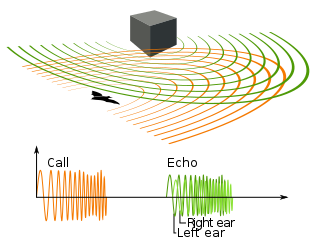
蝙蝠回声定位原理:橙色是叫声,绿色是回声
在低占空比回声定位中,蝙蝠可以将其呼叫分开并按时间返回回声。在回声返回之前,他们必须安排短时间通话才能结束。蝙蝠发出声音时会收缩中耳肌肉,因此可以避免使自己耳聋。通话和回声之间的时间间隔使他们可以放松这些肌肉,从而可以听到回声。[80]回声的延迟使蝙蝠能够估计其猎物的射程。[78]
在高占空比回声定位中,蝙蝠发出连续的声音并在频率上分开脉冲和回声。这些蝙蝠的耳朵被调到特定的频率范围。他们发出超出此范围的呼叫以避免耳聋。然后,他们利用飞行中的运动的多普勒频移,在微调的频率范围内接收回波。回波的多普勒频移产生与蝙蝠的猎物的运动和位置有关的信息。这些蝙蝠必须应对由于其飞行速度变化而引起的多普勒频移变化。他们已经适应于根据飞行速度改变脉冲发射频率,因此回声仍能在最佳听觉范围内返回。[81]
除回声定位的猎物外,蝙蝠耳还对飞蛾的翅膀颤动、,虫产生的声音以及ground和pre等地上猎物的运动敏感。蝙蝠耳的内表面上复杂的脊状结构有助于使聚焦信号清晰聚焦,并能被动收听猎物产生的任何其他声音。这些脊可被视为菲涅耳透镜的声学等效物,并存在于许多不相关的动物中,例如大ay-aye,较小的galago,蝙蝠耳狐,小鼠狐猴等。[82] [83] ] [84]蝙蝠可以使用耳屏(外耳皮肤的皮瓣)反射的回波的干扰模式来估计目标的高度。[78]
![The tiger moth (Bertholdia trigona) can jam bat echolocation[85][86].jpg The tiger moth (Bertholdia trigona) can jam bat echolocation[85][86].jpg](data/attachment/forum/202002/22/101243llllkikzqkdf8g0u.jpg)
虎蛾(Bertholdia trigona)会干扰蝙蝠的回声定位[85] [86]
通过反复扫描,蝙蝠可以在心理上构建出它们所处的环境及其猎物的准确图像。[87] [000] [86]有些蛾类已经利用了这种蛾子,例如虎蛾,它产生异味超声波信号,警告蝙蝠它们受到化学保护,因此令人反感。[85] [86]包括虎蛾在内的蛾类可以产生干扰蝙蝠回声定位的信号。许多蛾类都有一个称为鼓膜的听觉器官,它通过使飞蛾的飞行肌肉不规则地抽搐,从而将飞蛾送入随机的回避动作中,从而对传入的蝙蝠信号做出反应。[88] [89] [90]
视力
大多数微型蝙蝠的眼睛较小且发育不良,导致视力较差,但没有盲种。[91]大多数微型蝙蝠具有中视视觉,这意味着它们只能检测低水平的光,而其他哺乳动物则具有明视觉,从而可以实现彩色视觉。由于回声定位仅在短距离内有效,因此,微蝙蝠可能会利用其视觉进行定向,并在其栖息地和觅食地之间旅行时使用。有些物种可以检测紫外线(UV)。由于某些微型蝙蝠的主体具有明显的颜色,因此它们可能能够区分颜色。[43] [92] [93] [94]
Megabat物种的视力通常与人类视力相同,甚至更好。他们的视力可以适应夜视和日光视力,包括某些色觉。[94]
磁接收
微型蝙蝠利用磁感应技术,就像鸟类一样,对地球磁场具有很高的灵敏度。微型蝙蝠使用基于极性的指南针,这意味着它们与北方不同,与鸟类不同,鸟类利用磁场的强度来区分纬度,而纬度可用于长途旅行。其机理尚不清楚,但可能涉及磁铁矿颗粒。[95] [96]
温度调节
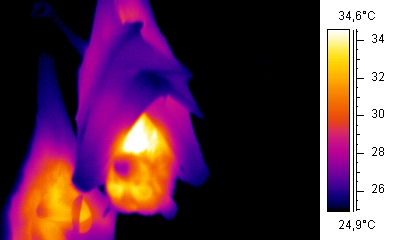
使用捕获的空气作为绝缘材料的蝙蝠的热像图
多数蝙蝠都是等温的(体温稳定),但泡状蝙蝠(Vespertilionidae),马蹄蝙蝠(Rhinolophidae),无尾蝙蝠(Molossidae)和弯翅蝙蝠(Miniopteridae)除外。使用异温疗法(体温可能会变化)。[97]与其他哺乳动物相比,蝙蝠具有很高的热导率。机翼充满血管,伸展时会散发热量。休息时,他们可以将翅膀缠在自己身上,以捕获一层温暖的空气。较小的蝙蝠通常具有比较大的蝙蝠更高的代谢率,因此需要消耗更多的食物以维持同温。[98]
蝙蝠在白天可能会避免飞行,以防止太阳过热,因为它们的深色机翼膜会吸收太阳辐射。如果环境温度过高,蝙蝠可能无法散热; [99]在极端条件下,它们会利用唾液为自身降温。[47]在巨型蝙蝠中,果蝇翼龙在一天中最热的部分栖息时会利用唾液和翅扇降温,同时栖息。[100]在微型蝙蝠中,Yuma myotis(Myotis yumanensis),墨西哥无尾蝙蝠和pallid蝙蝠(Antrozous pallidus)通过喘气,流涎和舔皮毛来促进温度高达45°C(113°F)。蒸发冷却;这足以消除其代谢热量产生的两倍。[101]
蝙蝠在其翅膀边缘延伸的血管网络的动脉侧还具有一个括约肌瓣膜系统。当完全打开时,这些可使含氧的血液流过穿过机翼膜的毛****细血管网络;收缩后,它们直接绕过机翼毛细血管直接流向静脉。这允许蝙蝠控制通过飞行膜交换的热量,从而允许它们在飞行过程中释放热量。许多其他哺乳动物也将毛细血管网络用于超大耳朵以达到相同目的。[102]
麻木
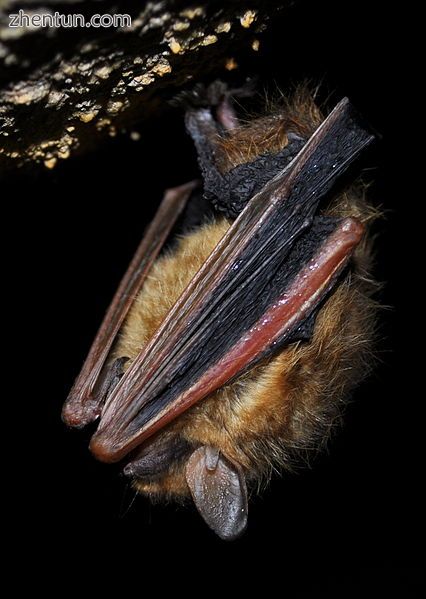
三色蝙蝠(Perimyotis subflavus)在torpor中
酚醛是一种活动减少的状态,其中体温和新陈代谢降低,对微型蝙蝠尤其有用,因为它们在活跃时会消耗大量能量,依赖于不可靠的食物来源,并且储存脂肪的能力有限。在这种状态下,他们的体温通常会降低到6–30°C(43–86°F),并且可能会将能量消耗减少50%至99%。所有微型蝙蝠中约有97%使用Torpor。[103]热带蝙蝠可以通过减少觅食时间,从而减少被捕食者捕食的机会来避免捕食。[104]一般认为,巨型蝙蝠是等温的,但是已知三种重量约50克(1.8盎司)的小型巨型蝙蝠会使用torpor:普通的开花蝙蝠(Syconycteris australis),长舌的花蜜蝙蝠(圆头蝙蝠(Macroglossus minimus)和东部管鼻蝙蝠(Nyctimene robinsoni)。超级蝙蝠的夏季状态比冬季更长。[105]
冬眠期间,蝙蝠进入r状态,并在其冬眠期的99.6%内降低体温;即使在觉醒期间,当他们使体温恢复到正常水平时,有时也会进入较浅的酸痛状态,被称为“异热觉醒”。[106] [107]有些蝙蝠在高温下休眠,以保持夏季凉爽。[107]
长时间迁徙过程中的异温蝙蝠可能会在夜间飞翔,并在白天成虫栖息。与白天候鸟和夜间觅食的候鸟不同,夜间蝙蝠在旅行和进食之间存在冲突。节省的能量减少了他们的觅食需求,并且减少了迁徙的持续时间,这可以防止他们在陌生的地方花费过多的时间,并减少捕食。在某些物种中,怀孕的人可能不使用Torpor。[108] [109]
尺寸
最小的蝙蝠是Kitti的猪鼻蝙蝠(Craseonycteris thonglongyai),长29-34毫米(1.1-1.3英寸),翼展15厘米(5.9英寸),重2-2.6克(0.071-0.092盎司)。[ 110] [111] 除了伊特鲁里亚sh之外,它还可以说是最小的现存哺乳动物。[112] 最大的蝙蝠是少数种类的翼龙(Pteropus megabat)和巨型金冠飞狐(Acerodon jubatus),它们的重量为1.6千克(3.5磅),翼展为1.7米(5.6英尺)。[113] 较大的蝙蝠倾向于使用较低的频率,而较小的蝙蝠则倾向于使用较高的频率。 高频回声定位更适合检测较小的猎物。 大蝙蝠的饮食中可能缺少小猎物,因为它们无法检测到它们。[114] 特定蝙蝠物种的适应性可以直接影响可供其使用的猎物。[115]
生态
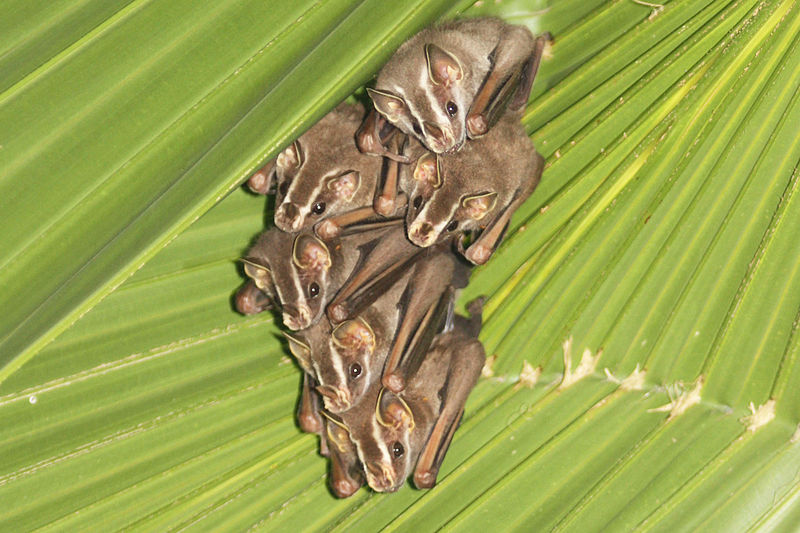
哥斯达黎加的制蝙蝠(Uroderma bilobatum)
飞行使蝙蝠成为分布最广泛的哺乳动物群体之一。[116]除北极,南极和一些孤立的海洋岛屿外,蝙蝠几乎存在于地球上的每个栖息地。[117]热带地区的物种往****往比温带地区的物种更多。[118]从海边到山脉和沙漠,不同物种在不同季节选择不同的栖息地,但它们需要合适的栖息地。蝙蝠栖息地可以发现在凹陷,缝隙,树叶甚至是人造结构中,并且包括蝙蝠用树叶建造的“帐篷”。[119]巨型蝙蝠通常栖息在树上。[120]大多数微型蝙蝠是夜间活动的[121],而大型蝙蝠通常是昼夜的或晚上的。[122] [123]
在温带地区,一些微型蝙蝠迁徙数百公里到冬季的冬眠窝点; [124]其他在寒冷的天气里进入微风,在温暖的天气允许昆虫活跃时觅食。[125]其他人则在冬天躲进山洞,冬眠长达六个月。[125]微型蝙蝠很少在雨中飞翔。它干扰了他们的回声定位,使他们无法狩猎。[126]
食物和喂养
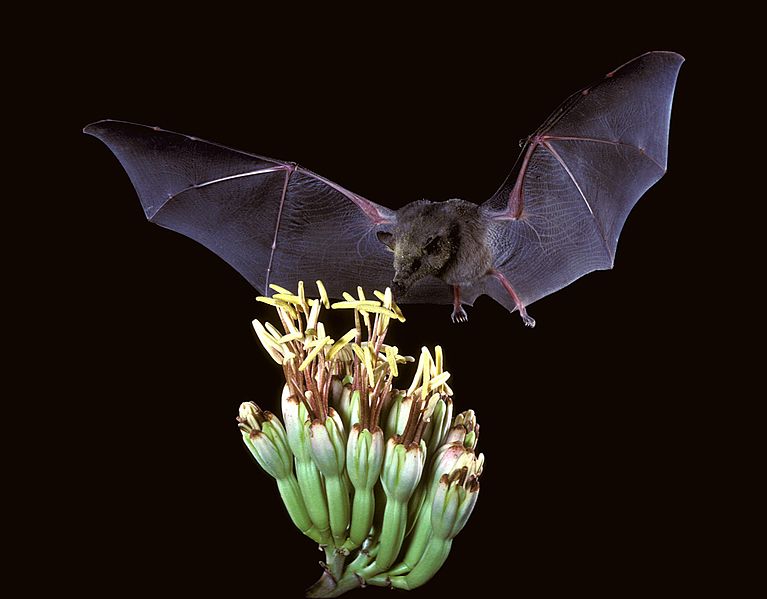
从仙人掌喝墨西哥长舌的蝙蝠(Choeronycteris mexicana)
不同种类的蝙蝠具有不同的饮食,包括昆虫,花蜜,花粉,水果甚至脊椎动物。[127]巨型蝙蝠主要是水果,花蜜和花粉的食用者。[122]由于蝙蝠体型小,高代谢和通过飞行迅速燃烧能量,因此蝙蝠必须消耗大量的食物来适应它们的体型。食虫性蝙蝠的体重可能超过其体重的120%,而食肉性蝙蝠的体重可能超过其体重的两倍。[128]他们每天晚上可以行进很远的距离,以寻找食物寻找蝙蝠(Euderma maculatum)长达38.5公里(23.9英里)。[129]蝙蝠使用各种狩猎策略。[114]蝙蝠从所吃的食物中获取大部分水分。 [130]许多物种还从湖泊和溪流等水源中喝水,飞越地表并将其舌头浸入水中。[130]
整个手足类正在丧失合成维生素C的能力。[131]在对六个主要科(包括以昆虫和水果为食的主要蝙蝠科)中的34个蝙蝠物种进行的测试中,发现它们都丧失了合成它的能力,并且这种丧失可能是由于一个单一的突变而源自一个共同的蝙蝠祖先。 [132] 至少有两种蝙蝠,即食食性蝙蝠(Rousettus leschenaultii)和食虫性蝙蝠(Hipposideros armiger)保留了产生维生素C的能力。[133]
昆虫
大多数微型蝙蝠,特别是在温带地区,以昆虫为食。[127]食虫蝙蝠的饮食可能跨越许多种类,[134]包括苍蝇,蚊子,甲虫,飞蛾,蚱猛,,白蚁,蜜蜂,黄蜂。[40] [135] [136]大量的墨西哥无尾蝙蝠(Tadarida brasiliensis)在得克萨斯州中部飞出地面数百米,以飞蛾为食。[136]像小棕蝙蝠(Myotis lucifugus)这样的在飞行中猎杀昆虫的物种,可能会用嘴在空中捕获昆虫,然后在空中吃掉它,或者使用它们的尾膜或翅膀将昆虫oop起并携带。到嘴里。[137] [138]蝙蝠还可能把昆虫带回栖所并在那里吃。[139]移动速度较慢的蝙蝠物种,例如棕色长耳蝙蝠(Plecotus auritus)和许多马蹄蝙蝠物种,可能会从植物中捕获昆虫或从中捕获昆虫,或者从栖息处捕杀它们。[40]与热带蝙蝠相比,生活在高纬度的食虫蝙蝠必须消耗具有更高能量价值的猎物。[140]
水果和花蜜
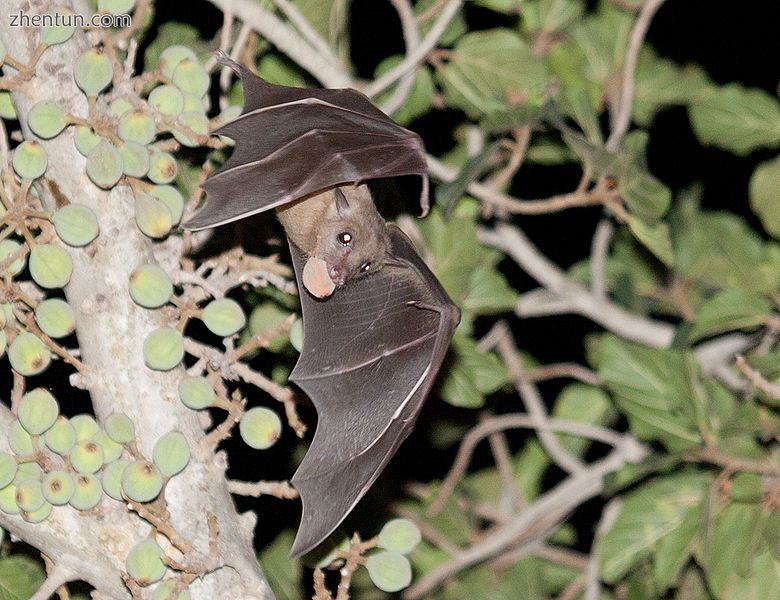
携带无花果的埃及果蝠(Rousettus aegyptiacus)
在两个主要子订单中都发现了水果饮食或饮食。蝙蝠喜欢成熟的果实,用牙齿将其从树上摘下。他们飞回栖息地吃水果,吸出果汁,将种子和果肉吐到地面上。 [141] [142]这有助于分散这些果树的种子,这些种子可能会生根并在蝙蝠离开的地方生长。许多植物依靠蝙蝠进行种子传播。[141] [142]据记录,牙买加的果蝠(Artibeus jamaicensis)携带的果实重量为3–14克(0.11–0.49盎司),甚至高达50克(1.8盎司)。[143]
食花蜜的蝙蝠获得了特殊的适应。这些蝙蝠的口吻很长,舌头长而细密,可伸长,可以帮助它们以特定的花朵和植物为食。[142] [144]管嘴状的花蜜蝙蝠(Anoura fistulata)相对于它的体型拥有最长的舌头。这对他们的授粉和喂养有利。它们狭长的舌头可以深入到一些花朵的长杯状中。当舌头缩回时,它会在肋骨内盘绕。[144]由于这些特征,采食花蜜的蝙蝠在短缺时不易转向其他食物来源,因此比其他类型的蝙蝠更容易灭绝。[145] [146]花蜜摄食还有助于多种植物,因为这些蝙蝠充当传粉媒介,因为花粉在摄食时会附着在其皮毛上。大约有500种开花植物依靠蝙蝠授粉,因此往往在夜间开放花朵。[142]许多雨林植物都依赖蝙蝠授粉。[147]
脊椎动物
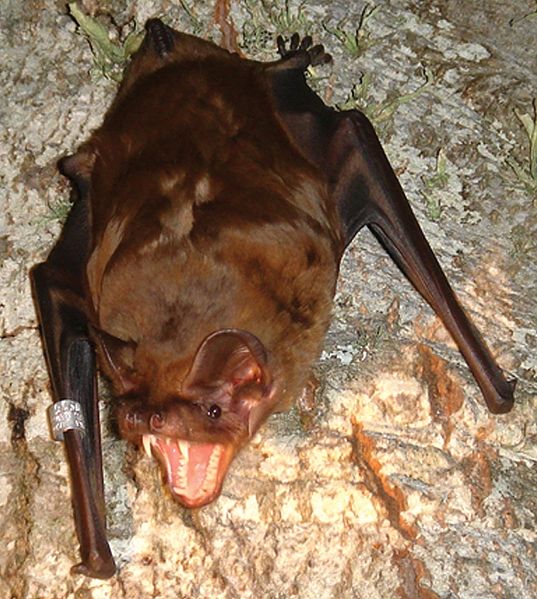
更大的夜蛾蝙蝠(Nyctalus lasiopterus)用它的大牙齿抓鸟。[148]
一些蝙蝠捕食其他脊椎动物,例如鱼类,青蛙,蜥蜴,鸟类和哺乳动物。[40] [149] 例如,有条纹的蝙蝠(Trachops cirrhosus)擅长捉青蛙。 这些蝙蝠通过跟踪青蛙的交配来定位大群青蛙,然后用锋利的犬齿将它们从水面拔出。[150] 更大的夜蛾蝙蝠可以捕捉飞行中的鸟类。[148] 一些物种,例如更大的斗牛犬蝙蝠(Noctilio leporinus)捕捞鱼类。 他们利用回声定位来检测水面上的小波纹,俯冲并用后脚上特别大的爪抓住鱼,然后将猎物带入觅食栖所并食用。[151] 已知至少有两种蝙蝠会以其他蝙蝠为食:光谱蝙蝠(吸血鬼光谱)和幽灵蝙蝠(Macroderma gigas)。[152]
血液
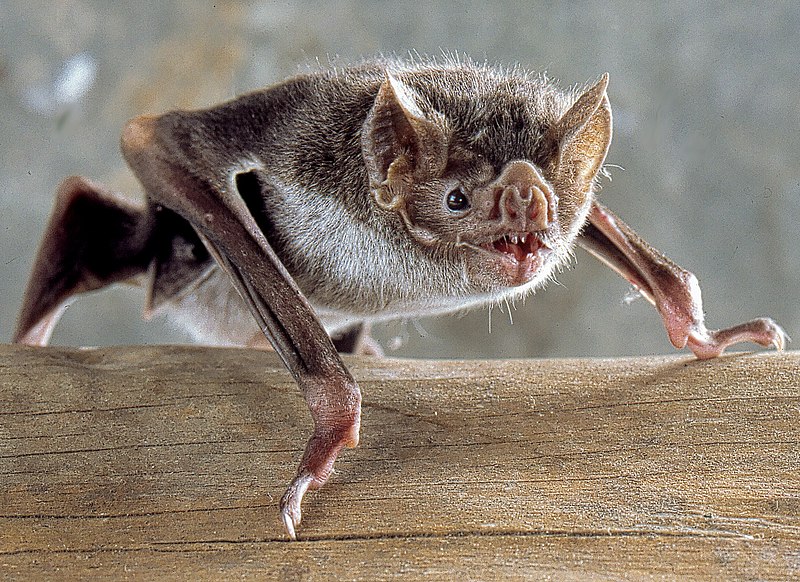
常见的吸血蝙蝠(Desmodus rotundus)以血液为食(吞噬)。
少数物种,特别是普通的,白翅的和有毛的吸血蝙蝠,仅以动物的血液为食(吞噬)。普通的吸血蝙蝠通常以牛等大型哺乳动物为食。毛茸茸的腿和白翅吸血鬼以鸟类为食。[153]吸血蝙蝠以睡觉的猎物为目标,可以检测到深呼吸。[154]鼻子中的热传感器帮助他们检测皮肤表面附近的血管。[155]他们用牙齿刺穿动物的皮肤,咬断一小片皮瓣,[156]并用舌头将血液包起来,舌头上有适合此目的的侧向凹槽。[157]唾液中的抗凝剂可防止血液凝结。[156]
捕食者,寄生虫和疾病
蝙蝠会受到猫头鹰,鹰和猎鹰等猛禽的捕食,并且会受到诸如猫等能够爬升的陆地掠食者的栖息。[158]已知有20种热带新大陆蛇捕获蝙蝠,它们通常在洞穴等避难所的入口处等待蝙蝠飞过。[159] J. Rydell和J. R. Speakman认为,蝙蝠在始新世中期和早期演化为夜行性,以避免掠食者。[158]到目前为止,一些动物学家认为该证据是模棱两可的。[160]
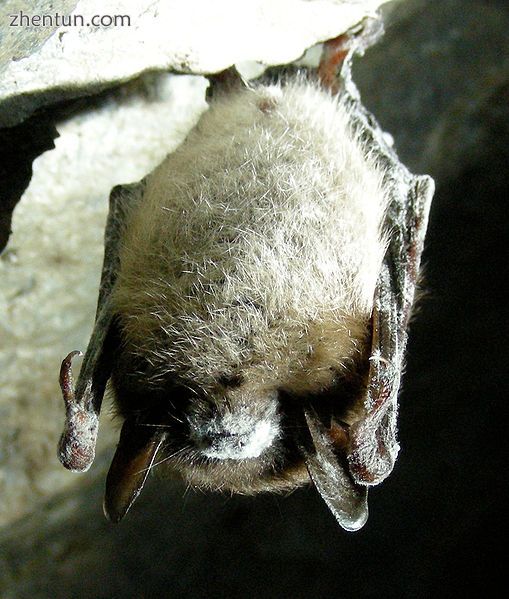
一只棕褐色蝙蝠伴白鼻子综合征
在外寄生物中,蝙蝠携带跳蚤和螨虫,以及特定的寄生虫,例如蝙蝠虫和蝙蝠蝇(夜蛾科和Streblidae)。[161] [162]蝙蝠是为数不多的不带虱子的非水生哺乳动物,可能是由于来自占据相同生态位的更专业的寄生虫的竞争所致。[162]
白鼻子综合症是与美国东部和加拿大数百万蝙蝠死亡相关的疾病。[163]该病以白木耳Pseudogymnoascus destructans的名字命名,发现该木耳生长在患病蝙蝠的枪口,耳朵和翅膀上。真菌大多在蝙蝠之间传播,并引起疾病。[164]这种真菌最早于2006年在纽约州中部发现,并迅速传播到佛罗里达州以北的整个美国东部。在受影响最严重的洞穴中,观察到死亡率为90–100%。[165]自2006年以来,新英格兰和大西洋中部各州目睹了整个物种完全灭绝,另一些物种的数量则从数十万甚至数百万减少到数百甚至更少。[166]新斯科舍省,魁北克省,安大略省和新不伦瑞克省经历了相同的死亡,加拿大政府为保护其领土上所有剩余的蝙蝠种群作了准备。[167]科学证据表明,真菌在较长时间内感染蝙蝠的冬天越长,死亡率越高。[168] [169] [170] 2014年,该感染穿越了密西西比河[171],2017年在得克萨斯州的蝙蝠上发现了这种病毒。[172]
蝙蝠是许多人畜共患病原体的自然库,[173]包括狂犬病,是许多蝙蝠种群中的特有种,[174] [175] [176]直接和在鸟粪中的组织胞浆菌病,[177]尼帕和亨德拉病毒,[178] ] [179],可能还有埃博拉病毒。[180] [181]它们的高迁移率,广泛的分布,长的寿命,物种的大量交感(范围重叠)以及社会行为使蝙蝠成为疾病的有利宿主和媒介。与啮齿动物相比,蝙蝠每个物种携带更多的人畜共患病毒,每种病毒与更多物种共享。[182]它们似乎对它们携带的许多病原体具有高度抵抗力,表明它们对免疫系统具有一定程度的适应性。[182] [183]**** [184]它们与牲畜和宠物的相互作用,包括吸血蝙蝠的捕食,偶然的相遇以及蝙蝠尸体的清除,增加了人畜共患病传播的风险。[175]蝙蝠是中国冠状病毒的天然宿主,与中国的严重急性呼吸系统综合症(SARS)有关,它们来自云南的一个洞穴,其中之一发展成SARS病毒。[177] [185] [ 186]
社会行为
社会结构
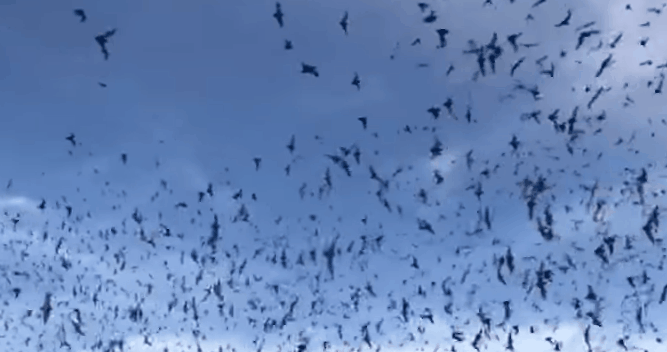
蕨菜蝙蝠洞(Bracken Bat Cave),拥有2000万只墨西哥自由尾蝙蝠
有些蝙蝠过着孤独的生活,而另一些蝙蝠则生活在超过一百万的殖民地中。[187] 生活在大殖民地中可以减少个体被捕食的风险。[40] 随着秋天的临近,温带蝙蝠可能会在冬眠的地方蜂拥而至。 这可能有助于将年轻带入冬眠的场所,使成年动物繁殖信号,并使成年动物与其他群体的动物繁殖。[188]
几个物种具有裂变融合的社会结构,其中大量蝙蝠聚集在一个栖息地,以及各个亚群的分裂和混合。 在这些社会中,蝙蝠能够维持长期的关系。[189] 这些关系中的一些由母系相关的雌性及其后代组成。[190] 食物共享和相互修饰可能发生在某些物种中,例如普通的吸血蝙蝠(Desmodus rotundus),它们加强了社会纽带。[191] [192]
通讯
![Acoustics of the songs of Mexican free-tailed bats[193].png Acoustics of the songs of Mexican free-tailed bats[193].png](data/attachment/forum/202002/22/101218bhrhqdhv76qx7sa7.png)
墨西哥无尾蝙蝠的歌声[193]
蝙蝠是哺乳动物中声音最强烈的动物之一,它们发出呼唤以吸引伴侣,寻找栖息地伙伴并捍卫资源。这些电话通常是低频电话,可以传播很长一段距离。[40] [194]墨西哥无尾蝙蝠是为数不多的像鸟一样“唱歌”的物种之一。男性唱歌吸引女性。歌曲包含三个短语:chi声,颤音和嗡嗡声,前者具有“ A”和“ B”音节。蝙蝠歌曲具有高度的典型性,但音节数,短语顺序和个人之间的短语重复情况有所不同。[193]在较大的长鼻蝙蝠(Phyllostomus hastatus)中,雌性在其栖息伴侣之间发出响亮的宽带呼叫,以形成群体凝聚力。寄居群体之间的通话有所不同,并且可能来自声音学习。[195]
在一项关于圈养埃及果蝠的研究中,研究人员可以识别出70%的定向呼叫是由哪个蝙蝠制造的,而60%则可以归类为四种情况:争吵食物,争吵在它们睡着的集群中的位置,抗议交配尝试,并争论彼此靠得很近。与不同的蝙蝠,特别是异性蝙蝠交流时,动物发出的声音略有不同。[196]在高度性二态的锤头蝙蝠(Hypsignathus monstrosus)中,雄性发出深沉,共鸣,单调的声音吸引雌性。飞行中的蝙蝠发出声音信号进行交通管制。 [194]大斗牛犬互相碰撞时会鸣喇叭。[194]
蝙蝠还可以通过其他方式进行交流。雄性小黄肩蝙蝠(Sturnira l髂骨)的肩腺在繁殖季节产生辛辣气味。像许多其他物种一样,它们的头发专门用于保留和分散分泌物。这样的头发在一些旧世界的巨型蝙蝠的脖子上形成了明显的领子。雄性较大的有翼翅蝙蝠(Saccopteryx bilineata)的翼囊中混合着唾液和尿液等身体分泌物,形成了一种香水,并撒在栖息地上,这种现象被称为“盐腌”。盐腌可能伴随唱歌。[194]
生殖和生活史
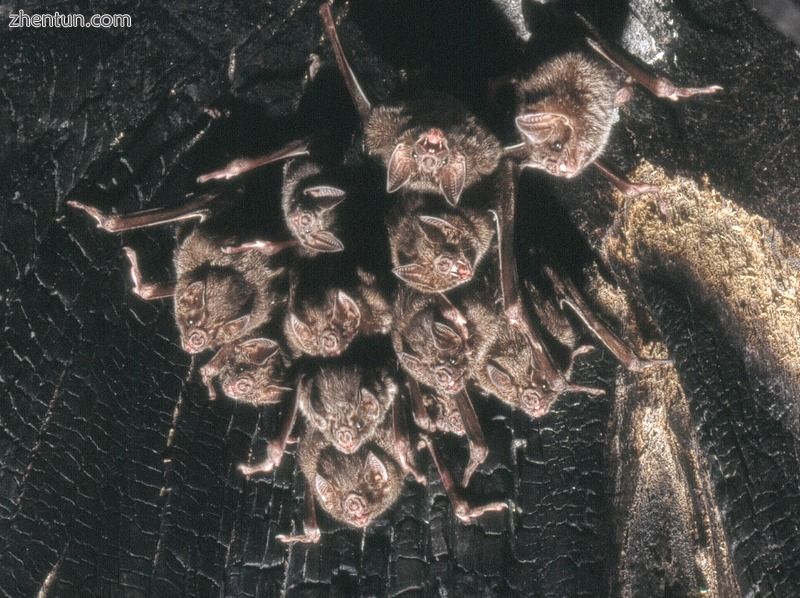
多性吸血蝙蝠群
策略
大多数蝙蝠是一夫多妻制,雄性与多雌性生活配。雄性长鼻蝠,夜蛾和吸血蝙蝠可能会要求并捍卫吸引雌性的资源,例如栖息地,并与这些雌性生活配。男性无力申领遗址,被迫生活在繁殖成功率较低的外围地区。[197] [40] [198] [199]诸如墨西哥的无尾蝙蝠和小棕蝙蝠这样的物种,都有两性生活配的滥交情况。这些蝙蝠在雌性中似乎偏向某些雄性。[40]在少数几个物种中,例如黄翅蝙蝠和光谱蝙蝠,成年雄性和雌性形成一夫一妻制。[40] [200]雄性生活配的雄性韭菜交配在蝙蝠中很少见[201],而在锤头蝙蝠中则很常见。[202]
交配
对于温带的活蝙蝠,交配发生在夏末和初秋。[203]热带蝙蝠可能在旱季交配。[204]交配后,雄性可能会留下一个交配的栓塞,以阻塞其他雄性的精子,从而确保其父子身份。[205]在冬眠物种中,已知雄性与雌性在to中交配。[40]雌蝙蝠使用各种策略来控制怀孕时间和年轻的出生,使分娩与最大的食物能力和其他生态因素相吻合。某些物种的雌性受精延迟,其中精子在交配后可在生殖道中保存数月。交配发生在秋天,但直到第二年春天才施肥。其他物种的植入延迟,其中卵在交配后受精,但在生殖道中保持自由状态,直到外部条件变得有利于生育和照顾后代为止。[206]在另一种策略中,受精和着床都会发生,但是胎儿的发育会延迟,直到良好的状况出现。在发育迟缓期间,母亲将使受精卵保持营养。由于先进的气体交换系统,该过程可以持续很长时间。[207]
生命周期
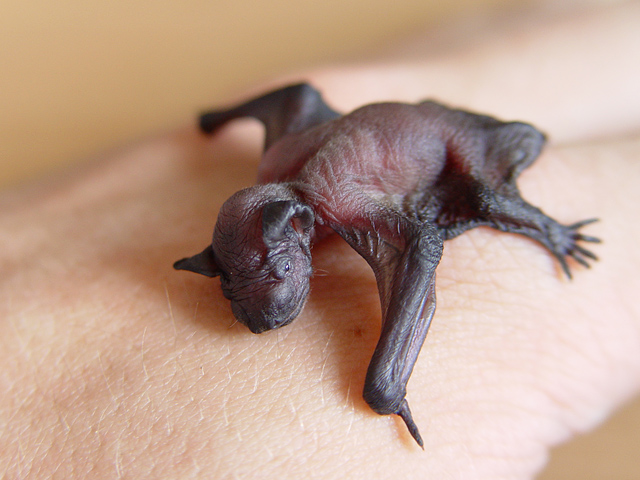
新生常见的伏翼属,伏翼
对于温带蝙蝠,通常在北半球的5月或6月出生。南半球的分娩于11月和12月发生。热带物种在雨季初生。[208]在大多数蝙蝠物种中,雌性每窝产下并产下一只幼崽。[209]刚出生时,蝙蝠幼崽的重量可能高达母亲的40%,[40]并且由于两半通过弹性韧带相连,雌性的骨盆带可能在出生时膨胀。[210]雌性通常以平头或水平姿势分娩,利用重力使分娩更容易。幼鸟首先出现在后方,这可能是为了防止机翼缠结,而雌鸟则将其放在机翼和尾巴的膜中。 [211] [212] [210]在许多物种中,雌性在产区殖民地生育并长大,并可能互相帮助。
年轻蝙蝠的照顾大部分来自母亲。在一夫一妻制物种中,父亲扮演着角色。雌性母乳喂养别的母亲的幼体的同种异体哺乳发生在几种物种中。这可能有助于增加雌性返回其出生菌落繁殖的物种的菌落大小。[40]幼蝙蝠的飞行能力与成年身体的发育和前肢的长度相吻合。对于小棕蝙蝠,这种情况发生在出生后约十八天。大多数物种的幼仔断奶发生在八十天之内。普通的吸血蝙蝠在其后代之外照顾其后代,而年轻的吸血蝙蝠在生命中晚于其他物种而获得独立。 [213]这可能是由于该物种以血液为基础的饮食难以每晚获得的。[213]
预期寿命
蝙蝠的最大寿命是其他类似大小的哺乳动物的三倍半。据记录,有六种在野生环境中生活了30年以上:棕色长耳蝙蝠(Plecotus auritus),棕色小蝙蝠(Myotis lucifugus),勃氏蝙蝠(Myotis brandti),小鼠耳短蝙蝠(Myotis blythii) )大马蹄蝙蝠(Rhinolophus ferrumequinum)和印度果蝠(Pteropus giganteus)。[214]一种与生活率理论相一致的假设将其与以下事实联系在一起:它们在冬眠时减慢了新陈代谢的速度。平均而言,冬眠的蝙蝠的寿命比不冬眠的蝙蝠更长。[215] [216]另一个假设是,飞行降低了死亡率,鸟类和滑行哺乳动物也是如此。产生多个幼仔的蝙蝠物种的寿命通常比仅生一个幼仔的物种的寿命短。由于洞穴中的捕食减少,洞穴栖居物种的寿命可能比非栖居物种更长。 [41] [217]在41年后,雄性勃兰特蝙蝠在野外被重新捕获。[216] [217]
与人的互动
保护

得克萨斯州圣安东尼奥市的蝙蝠栖所,1915年
蝙蝠保护国际组织[218]等组织旨在提高人们对蝙蝠的生态作用和面临的环境威胁的认识。在英国,所有蝙蝠均受到《野生动物和乡村法案》的保护,干扰蝙蝠或其栖息地可处以重罚。[219]在马来西亚沙捞越州,“所有蝙蝠” [220]受《 1998年野生动物保护条例》 [220]保护,但当地社区仍在食用无毛蝙蝠(Cheiromeles torquatus)等物种。[221]人类在现代历史上造成了几种蝙蝠的灭绝,最近的一次是圣诞节岛小鹦鹉(Pipistrellus murrayi),该物种于2009年被宣布灭绝。[222]
许多人筑起蝙蝠屋来吸引蝙蝠。[223] 1991年,佛罗里达大学的蝙蝠屋是全球最大的人工栖息地,约有40万居民。[224]在英国,第二次世界大战时壁厚且部分地下的药盒被改造成蝙蝠的栖所,[225] [226],偶尔建造专门建造的蝙蝠屋以减轻道路或其他发展对栖息地的破坏。[227] [ 228]有时会安装洞穴门,以限制人类进入敏感或濒临灭绝的蝙蝠物种的洞穴。大门的设计不限制气流,因此可以维持洞穴的微生态系统。[229]在美国发现的47种蝙蝠中,已知35种使用人类结构,包括建筑物和桥梁。 14个物种使用蝙蝠屋。[230]
非洲,亚洲和环太平洋地区的国家都食用蝙蝠。在某些情况下,例如在关岛,因猎捕食肉而变得濒临灭绝。[231]有证据表明,风力涡轮机会产生足够的气压伤(压力破坏)来杀死蝙蝠。[232]蝙蝠具有典型的哺乳动物肺部,被认为比鸟类的肺部对突然的气压变化更敏感,从而使其更容易致命。[233] [234] [235] [236] [237]蝙蝠可能被涡轮吸引,也许是寻找栖息地,从而增加了死亡率。[233]声学威慑作用可能有助于降低风电场中的蝙蝠死亡率。[238]
文化意义
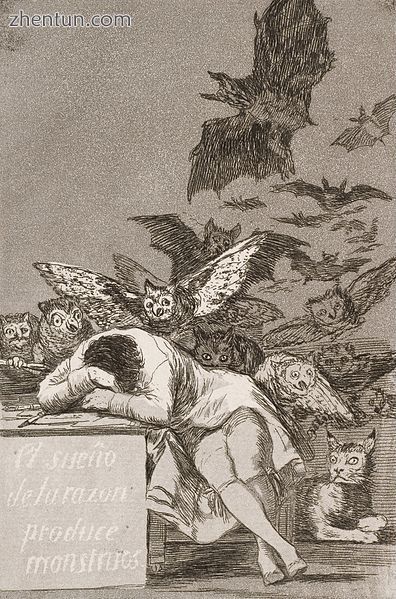
弗朗西斯科·戈雅(Francisco Goya),《理性睡眠》中的怪物产生,1797年
由于蝙蝠是哺乳动物,但可以飞行,因此在各种传统中它们都被认为是边缘生物。[239]在许多文化中,包括在欧洲,蝙蝠与黑暗,死亡,巫术和恶意有关。[240]在诸如克里克,切诺基和阿帕奇等美洲原住民中,蝙蝠是一种骗子精神。在坦桑尼亚,一种有翼的蝙蝠状生物被称为“波波瓦(Popobawa)”,据信是一种变身的恶魔,攻击并毒打了受害者。[241]在阿兹台克人的神话中,蝙蝠象征着死亡,毁灭和腐烂的土地。[242] [243] [244]尼日利亚东部的一个传说告诉作者,蝙蝠在造成其伴侣伴侣丛林鼠死亡后养成了夜间活动习惯,如今白天躲藏起来以免被捕。[245]
在某些文化中,对蝙蝠的描述更为积极。在中国,蝙蝠与幸福,快乐和吉祥联系在一起。五只蝙蝠象征着“五福”:长寿,财富,健康,爱美和和平死亡。[246]蝙蝠在汤加是神圣的,通常被认为是可分离灵魂的物理表现。[247]在中美洲的Zapotec文明中,蝙蝠神掌管着玉米和肥力。[248]
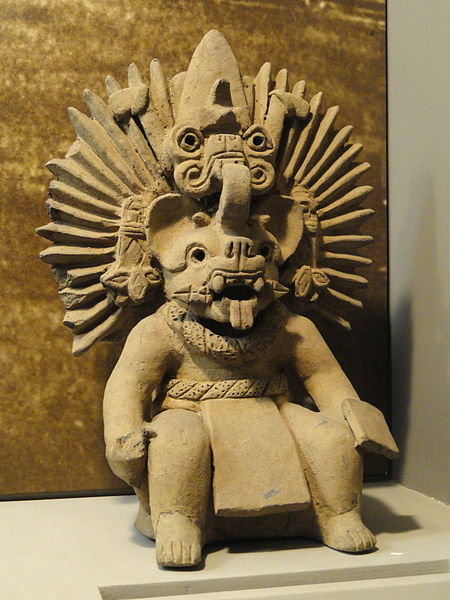
Zapotec蝙蝠神,瓦哈卡州,公元350–500年
莎士比亚·麦克白的怪异姐妹在酿造中使用了蝙蝠的皮毛。[249]在西方文化中,蝙蝠通常是黑夜及其预兆的象征。蝙蝠是与夜间虚构人物相关的主要动物,既是吸血鬼,例如吸血鬼伯爵(Count Dracula),又是吸血鬼瓦尼(Varney),[250]和英雄,例如蝙蝠侠。[251]肯尼斯·欧佩尔(Kenneth Oppel)的银翼小说讲述了一只年轻的蝙蝠的冒险经历,[252]以北美银发蝙蝠为基础[253]。
蝙蝠有时在西班牙和法国被用作纹章的象征,出现在巴伦西亚,马略卡岛帕尔马,弗拉加,阿尔瓦塞特和蒙绍维特的纹章中。[254] [255] [256]美国的三个州都有一个官方州蝙蝠。德克萨斯州和俄克拉荷马州以墨西哥无尾蝙蝠为代表,而弗吉尼亚州以弗吉尼亚大耳蝠(Corynorhinus townsendii virginianus)为代表。[257]
经济学
食虫蝙蝠对农民特别有用,因为它们可以控制农业害虫的数量并减少使用农药的需求。据估计,蝙蝠每年可为美国的农业产业节省37亿至530亿美元的农药和农作物损害。这也防止了过度使用农药,农药会污染周围的环境,并可能导致对子孙后代的抵抗。[258]
蝙蝠粪是一种鸟粪,富含硝酸盐,并从山洞中开采出来用作肥料。[259]在美国内战期间,从洞穴收集硝石制成火药。以前人们以为这是蝙蝠鸟粪,但大部分硝酸盐都来自硝化细菌。[260]
得克萨斯州奥斯汀市的国会大道大桥是北美最大的城市蝙蝠殖民地的避暑胜地,据估计,那里有1,500,000墨西哥的无尾蝙蝠。 [261]每年约有10万名游客在暮色中参观桥梁,看蝙蝠离开栖所。[261]
参考:
"Chiroptera" . Encyclop**dia Britannica. 6 (11th ed.). 1911. pp. 239–247.
"Bat". Dictionary. Retrieved 9 September 2017.
"Bat, noun 2". Online Etymology Dictionary. Retrieved 24 June 2013.
Liddell, Henry G.; Scott, Robert (eds.). "χε**ρ". A Greek-English Lexicon. Retrieved 9 September 2017.
Liddell, Henry G.; Scott, Robert (eds.). "πτερ**ν". A Greek-English Lexicon. Retrieved 9 September 2017.
Eiting, T. P.; Gunnell, G. F. (2009). "Global completeness of the bat fossil record". Journal of Mammalian Evolution. 16 (3): 151–173. doi:10.1007/s10914-009-9118-x.
Simmons, N. B.; Seymour, K. L.; Habersetzer, J.; Gunnell, G. F. (2008). " rimitive Early Eocene bat from Wyoming and the evolution of flight and echolocation". Nature. 451 (7180): 818–821. Bibcode:2008Natur.451..818S. doi:10.1038/nature06549. hdl:2027.42/62816. PMID 18270539. rimitive Early Eocene bat from Wyoming and the evolution of flight and echolocation". Nature. 451 (7180): 818–821. Bibcode:2008Natur.451..818S. doi:10.1038/nature06549. hdl:2027.42/62816. PMID 18270539.
" aleontologists Determine Original Color of Extinct Bats". SciNews. 29 September 2015. Retrieved 10 September 2017. aleontologists Determine Original Color of Extinct Bats". SciNews. 29 September 2015. Retrieved 10 September 2017.
Collearya, C.; Dolocanc, A.; Gardnerd, J.; Singha, Suresh; Wuttkee, M. (2015). "Chemical, experimental, and morphological evidence for diagenetically altered melanin in exceptionally preserved fossils". Proceedings of the National Academy of Sciences of the United States of America. 112 (41): 12592–12597. Bibcode:2015PNAS..11212592C. doi:10.1073/pnas.1509831112. PMC 4611652. PMID 26417094.
Van de Bussche, R. A.; Hoofer, S. R. (2004). " hylogenetic relationships among recent chiropteran families and the importance of choosing appropriate out-group taxa". Journal of Mammalogy. 85 (2): 321–330. doi:10.1644/1545-1542(2004)085<0321 hylogenetic relationships among recent chiropteran families and the importance of choosing appropriate out-group taxa". Journal of Mammalogy. 85 (2): 321–330. doi:10.1644/1545-1542(2004)085<0321 rarcf>2.0.Co;2. rarcf>2.0.Co;2.
Smith, D. "Chiroptera: Systematics". University of California Museum of Paleontology. Retrieved 9 September 2017.
Eick, G. N.; Jacobs, D. S.; Matthee, C. A. (2005). "A Nuclear DNA Phylogenetic Perspective on the Evolution of Echolocation and Historical Biogeography of Extant Bats (Chiroptera)". Molecular Biology and Evolution. 22 (9): 1869–1886. doi:10.1093/molbev/msi180. PMID 15930153. Several molecular studies have shown that Chiroptera belong to the Laurasiatheria (represented by carnivores, pangolins, cetartiodactyls, eulipotyphlans, and perissodactyls) and are only distantly related to dermopterans, scandentians, and primates (Nikaido et al. 2000; Lin and Penny 2001; Madsen et al. 2001; Murphy et al. 2001a, 2001b; Van Den Bussche and Hoofer 2004)
Pumo, D. E.; et al. (1998). "Complete Mitochondrial Genome of a Neotropical Fruit Bat, Artibeus jamaicensis, and a New Hypothesis of the Relationships of Bats to Other Eutherian Mammals". Journal of Molecular Evolution. 47 (6): 709–717. Bibcode:1998JMolE..47..709P. doi:10.1007/PL00006430. PMID 9847413.
Zhou, X.; et al. (2011). " hylogenomic Analysis Resolves the Interordinal Relationships and Rapid Diversification of the Laurasiatherian Mammals". Systematic Biology. 61 (1): 150–164. doi:10.1093/sysbio/syr089. PMC 3243735. PMID 21900649. hylogenomic Analysis Resolves the Interordinal Relationships and Rapid Diversification of the Laurasiatherian Mammals". Systematic Biology. 61 (1): 150–164. doi:10.1093/sysbio/syr089. PMC 3243735. PMID 21900649.
Tsagkogeorga, G.; Parker, J.; Stupka, E.; Cotton, J. A.; Rossiter, S. J. (2013). " hylogenomic analyses elucidate the evolutionary relationships of bats (Chiroptera)". Current Biology. 23 (22): 2262–2267. doi:10.1016/j.cub.2013.09.014. PMID 24184098. hylogenomic analyses elucidate the evolutionary relationships of bats (Chiroptera)". Current Biology. 23 (22): 2262–2267. doi:10.1016/j.cub.2013.09.014. PMID 24184098.
Zhang, G.; Cowled, C.; Shi, Z.; Huang, Z.; Bishop-Lilly, K. A.; Fang, X.; Wynne, J. W.; Xiong, Z.; Baker, M. L.; Zhao, W.; Tachedjian, M.; Zhu, Y.; Zhou, P.; Jiang, X.; Ng, J.; Yang, L.; Wu, L.; Xiao, J.; Feng, Y.; Chen, Y.; Sun, X.; Zhang, Y.; Marsh, G. A.; Crameri, G.; Broder, C. C.; Frey, K. G.; Wang, L.-F.; Wang, J. (2012). "Comparative Analysis of Bat Genomes Provides Insight into the Evolution of Flight and Immunity". Science. 339 (6118): 456–460. Bibcode:2013Sci...339..456Z. doi:10.1126/science.1230835. PMID 23258410.
Agnarsson, I.; Zambrana-Torrelio, C. M.; Flores-Saldana, N. P.; May-Collado, L. J. (2011). "A time-calibrated species-level phylogeny of bats (Chiroptera, Mammalia)". PLoS Currents. 3: RRN1212. doi:10.1371/currents.RRN1212. PMC 3038382. PMID 21327164.
Teeling, E.C.; Springer, M. S.; Madsen, O.; Bates, P.; O'Brien, S. J.; Murphy, W. J. (2005). "A Molecular Phylogeny for Bats Illuminates Biogeography and the Fossil Record". Science. 307 (5709): 580–584. Bibcode:2005Sci...307..580T. doi:10.1126/science.1105113. PMID 15681385.
Pettigrew, J. D.; Maseko, B. C.; Manger, P. R. (2008). " rimate-like retinotectal decussation in an echolocating megabat, Rousettus aegyptiacus". Neuroscience. 153 (1): 226–31. doi:10.1016/j.neuroscience.2008.02.019. PMID 18367343. rimate-like retinotectal decussation in an echolocating megabat, Rousettus aegyptiacus". Neuroscience. 153 (1): 226–31. doi:10.1016/j.neuroscience.2008.02.019. PMID 18367343.
Simmons, N. B.; Seymour, K. L.; Habersetzer, J.; Gunnell, G. F. (2008). " rimitive early Eocene bat from Wyoming and the evolution of flight and echolocation". Nature. 451 (7180): 818–816. Bibcode:2008Natur.451..818S. doi:10.1038/nature06549. hdl:2027.42/62816. PMID 18270539. rimitive early Eocene bat from Wyoming and the evolution of flight and echolocation". Nature. 451 (7180): 818–816. Bibcode:2008Natur.451..818S. doi:10.1038/nature06549. hdl:2027.42/62816. PMID 18270539.
"Bat fossil solves evolution poser". BBC News. 13 February 2008. Retrieved 17 December 2017.
Norberg, U. M. (1994). Wainwright, P. C.; Reilly, S. M. (eds.). Ecological Morphology: Integrative Organismal Biology. University of Chicago Press. pp. 206–208. ISBN 978-0-226-86995-7.
Bishop, K. L. (2008). "The Evolution of Flight in Bats: Narrowing the Field of Plausible Hypotheses". The Quarterly Review of Biology. 83 (2): 153–169. doi:10.1086/587825. PMID 18605533.
Kaplan, Matt (2011). "Ancient bats got in a flap over food". Nature. doi:10.1038/nature.2011.9304.
Teeling; Teeling, E. C.; Scally, M.; Kao, D. J.; Romagnoli, M. L.; Springer, M. S. (2000). "Molecular evidence regarding the origin of echolocation and flight in bats". Nature. 403 (6766): 188–192. Bibcode:2000Natur.403..188T. doi:10.1038/35003188. PMID 10646602.
Springer, M. S.; Teeling, E. C.; Madsen, O.; Stanhope, M. J.; De Jong, W. W. (2001). "Integrated fossil and molecular data reconstruct bat echolocation". Proceedings of the National Academy of Sciences. 98 (11): 6241–6246. Bibcode:2001PNAS...98.6241S. doi:10.1073/pnas.111551998. PMC 33452. PMID 11353869.
L., G.; Wang, J.; Rossiter, S. J.; Jones, G.; Zhang, S. (2007). "Accelerated FoxP2 evolution in echolocating bats". PLOS ONE. 2 (19): e900. Bibcode:2007PLoSO...2..900L. doi:10.1371/journal.pone.0000900. PMC 1976393. PMID 17878935.
DesRoche, K.; Fenton, M. B.; Lancaster, W. C. (2007). "Echolocation and the thoracic skeletons of bats: a comparative morphological study". Acta Chiropterologica. 9 (2): 483–494. doi:10.3161/1733-5329(2007)9[483:EATTSO]2.0.CO;2.
Li, G.; Wang, J.; Rossiter, S. J.; Jones, G.; Cotton, J. A.; Zhang, S. (2008). "The hearing gene 快蛋白 reunites the echolocating bats". Proceedings of the National Academy of Sciences of the United States of America. 105 (37): 13959–13964. Bibcode:2008PNAS..10513959L. doi:10.1073/pnas.0802097105. PMC 2544561. PMID 18776049.
Wang, Zhe; Zhu, Tengteng; Xue, Huiling; Fang, Na; Zhang, Junpeng; Zhang, Libiao; Pang, Jian; Teeling, Emma C.; Zhang, Shuyi (2017). " renatal development supports a single origin of 喉 echolocation in bats". Nature Ecology & Evolution. 1 (2): 21. doi:10.1038/s41559-016-0021. PMID 28812602. renatal development supports a single origin of 喉 echolocation in bats". Nature Ecology & Evolution. 1 (2): 21. doi:10.1038/s41559-016-0021. PMID 28812602.
Lei, M.; Dong, D. (2016). " hylogenomic analyses of bat subordinal relationships based on transcriptome data". Scientific Reports. 6: 27726. Bibcode:2016NatSR...627726L. doi:10.1038/srep27726. PMC 4904216. PMID 27291671. hylogenomic analyses of bat subordinal relationships based on transcriptome data". Scientific Reports. 6: 27726. Bibcode:2016NatSR...627726L. doi:10.1038/srep27726. PMC 4904216. PMID 27291671.
Neuweiler, Gerhard (2000). " hylogeny and systematics". The Biology of Bats. Oxford University Press. pp. 287–299. ISBN 978-0195099508. hylogeny and systematics". The Biology of Bats. Oxford University Press. pp. 287–299. ISBN 978-0195099508.
Prothero, D. R. (2017). "Laurasiatheria: Chiroptera". The Princeton Field Guide to Prehistoric Mammals. Princeton University Press. pp. 112–116. ISBN 978-0-691-15682-8.
Hutcheon, J. M.; Garland, T. (2004). "Are Megabats Big?". Journal of Mammalian Evolution. 11 (3/4): 257. doi:10.1023/B:JOMM.0000047340.25620.89.
Holland, R. A. (2004). "Echolocation signal 结构 in the Megachiropteran bat Rousettus aegyptiacus Geoffroy 1810". Journal of Experimental Biology. 207 (25): 4361–4369. doi:10.1242/jeb.01288. PMID 15557022.
Brown, W. M. (2001). "Natural selection of mammalian brain components". Trends in Ecology and Evolution. 16 (9): 471–473. doi:10.1016/S0169-5347(01)02246-7.
Stephen, J.; Olney, P. (1994). Creative Conservation: Interactive Management of Wild and Captive Animals. Springer. p. 352. ISBN 978-0412495700.
Wilson, D.E.; Mittermeier, R.A., eds. (2019). Handbook of the Mammals of the World – Volume 9. Barcelona: Lynx Ediciones. pp. 1–1008. ISBN 978-84-16728-19-0.
Fleming, T. (2003). A Bat Man in the Tropics: Chasing El Duende. University of California Press. p. 165. ISBN 978-0520236066.
Jones, G. (2001). "Bats". In MacDonald, D. (ed.). The Encyclopedia of Mammals (2nd ed.). Oxford University Press. pp. 754–775. ISBN 978-0-7607-1969-5.
Greenhall, A.M.; Joermann, G.; Schmidt, U. (1983). "Desmodus rotundus". Mammalian Species. 202 (202): 1–6. doi:10.2307/3503895. JSTOR 3503895.
Senawi, J.; Schmieder, D.; Siemers, B.; Kingston, T. (2015). "Beyond size – morphological predictors of bite force in a diverse insectivorous bat assemblage from Malaysia". Functional Ecology. 29 (11): 1411–1420. doi:10.1111/1365-2435.12447.
Hunter, P. (2007). "The nature of flight: The molecules and mechanics of flight in animals". Science and Society. 8 (9): 811–813. doi:10.1038/sj.embor.7401050. PMC 1973956. PMID 17767190.
McCracken, G. F.; Safi, K.; Kunz, T. H.; Dechmann, D. K. N.; Swartz, S. M.; Wikelski, M. (9 November 2016). "Airplane tracking documents the fastest flight speeds recorded for bats". Royal Society Open Science. 3 (11): 160398. Bibcode:2016RSOS....360398M. doi:10.1098/rsos.160398. PMC 5180116. PMID 28018618.
Sears, K. E.; Behringer, R. R.; Rasweiler, J. J.; Niswander, L. A. (2006). "Development of bat flight: Morphologic and molecular evolution of bat wing digits". Proceedings of the National Academy of Sciences. 103 (17): 6581–6586. Bibcode:2006PNAS..103.6581S. doi:10.1073/pnas.0509716103. PMC 1458926. PMID 16618938.
Kirkpatrick, S. J. (1994). "Scale effects on the stresses and safety factors in the wing bones of birds and bats". Journal of Experimental Biology. 190: 195–215. PMID 7964391.
Pennycuick, C. J. (2008). "Bats". Modelling the Flying Bird. Elsevier. pp. 136–143. ISBN 978-0-12-374299-5.
Marshall, K. L.; Chadha, M.; deSouza, L. A.; Sterbing-D'Angelo, S. J.; Moss, C. F.; Lumpkin, E. A. (2015). "Somatosensory substrates of flight control in bats". Cell Reports. 11 (6): 851–858. doi:10.1016/j.celrep.2015.04.001. PMC 4643944. PMID 25937277.
Brown University (2007). "Bats In Flight Reveal Unexpected Aerodynamics". ScienceDaily. Retrieved 31 October 2017.
Riskin, D. K.; Bergou, A.; Breuer, K. S.; Swartz, S. M. (2012). "Upstroke wing flexion and the inertial cost of bat flight". Proceedings of the Royal Society B: Biological Sciences. 279 (1740): 2945–2950. doi:10.1098/rspb.2012.0346. PMC 3385481. PMID 22496186.
Roberts, W. C. (2006). "Facts and ideas from anywhere". Proceedings (Baylor University. Medical Center). 19 (4): 425–434. doi:10.1080/08998280.2006.11928217. PMC 1618737. PMID 17106509.
Irwin, N. (1997). "Wanted DNA samples from Nyctimene or Paranyctimene Bats" (PDF). The New Guinea Tropical Ecology and Biodiversity Digest. 3: 10. Archived from the original (PDF) on 22 July 2008.
Sterbing-D'Angelo, S.; Chadha, M.; Chiu, C.; Falk, B.; Xian, W.; Barcelo, J.; Zook, J. M.; Moss, C. F. (2011). "Bat wing sensors support flight control". Proceedings of the National Academy of Sciences of the United States of America. 108 (27): 11291–11296. Bibcode:2011PNAS..10811291S. doi:10.1073/pnas.1018740108. PMC 3131348. PMID 21690408.
Mehlhorn, H. (2013). Bats (Chiroptera) as Vectors of Diseases and Parasites: Facts and Myths. Springer. pp. 2–27. ISBN 978-3-642-39333-4.
Makanya, A. N.; Mortola, J. P. (2017). "The structural design of the bat wing web and its possible role in gas exchange". Journal of Anatomy. 211 (6): 687–697. doi:10.1111/j.1469-7580.2007.00817.x. PMC 2375846. PMID 17971117.
Fenton & Simmons 2015, pp. 166–167.
"Leading Edge Vortex Allows Bats to Stay Aloft, Aerospace Professor Reports". USC Viterbi School of Engineering. 29 February 2008.
Fenton, M. B.; Crerar, L. M. (1984). "Cervical Vertebrae in Relation to Roosting Posture in Bats". Journal of Mammalogy. 65 (3): 395–403. doi:10.2307/1381085. JSTOR 1381085.
Fenton & Simmons 2015, p. 78.
Riskin, D. K.; Parsons, S.; Schutt, W. A., Jr.; Carter, G. G.; Hermanson, J. W. (2006). "Terrestrial locomotion of the New Zealand short-tailed bat Mystacina tuberculata and the common vampire bat Desmodus rotundus" (PDF). Journal of Experimental Biology. 209 (9): 1725–1736. doi:10.1242/jeb.02186. PMID 16621953.
Jones, T. W. (1852). "Discovery That the Veins of the Bat's Wing (Which are Furnished with Valves) are Endowed with Rythmical Contractility, and That the Onward Flow of Blood is Accelerated by Each Contraction". Philosophical Transactions of the Royal Society of London. 142: 131–136. doi:10.1098/rstl.1852.0011. JSTOR 108539.
Dongaonkar, R. M.; Quick, C. M.; Vo, J. C.; Meisner, J. K.; Laine, G. A.; Davis, M. J.; Stewart, R. H. (15 June 2012). "Blood flow augmentation by intrinsic venular contraction in vivo". American Journal of Physiology. Regulatory, Integrative and Comparative Physiology. 302 (12): R1436–R1442. doi:10.1152/ajpregu.00635.2011. PMC 3378342. PMID 22513742.
Langley, L. (29 August 2015). "Bats and Sloths Don't Get Dizzy Hanging Upside Down—Here's Why". National Geographic. Retrieved 10 June 2017.
Maina, J. N. (2000). "What it takes to fly: the structural and functional respiratory refinements in birds and bats". Journal of Experimental Biology. 203 (20): 3045–3064. PMID 11003817.
Suthers, Roderick A.; Thomas, Steven P; Suthers, Barbara A (1972). "Respiration, Wing-Beat and Ultrasonic Pulse Emission in an Echo-Locating Bat". Journal of Experimental Biology. 56 (56): 37–48. Retrieved 9 August 2019.
Ben-Hamo, Miriam; Muñoz-Garcia, Agustí; Larrain, Paloma; Pinshow, Berry; Korine, Carmi; Williams, Joseph B. (29 June 2016). "The cutaneous lipid composition of bat wing and tail membranes: a case of convergent evolution with birds". Proceedings of the Royal Society B: Biological Sciences. 283 (1833): 20160636. doi:10.1098/rspb.2016.0636. PMC 4936036. PMID 27335420.
Jürgens, Klaus Dieter; Bartels, Heinz; Bartels, Rut (1981). "Blood oxygen transport and organ weights of small bats and small non-flying mammals". Respiration Physiology. 45 (3): 243–260. doi:10.1016/0034-5687(81)90009-8. PMID 7330485.
Martini, Frederic (2015). Visual anatomy & physiology. Pearson. pp. 704–705. ISBN 978-0-321-91874-1. OCLC 857980151.
WANG, LI; LI, GANG; WANG, JINHONG; YE, SHAOHUI; JONES, GARETH; ZHANG, SHUYI (2009). "Molecular cloning and evolutionary analysis of the GJA1 (connexin43) gene from bats (Chiroptera)". Genetics Research. 91 (2): 101–9. doi:10.1017/s0016672309000032. PMID 19393126.
Holbrook, K. A.; Odland, G. F. (1978). "A collagen and elastic network in the wing of the bat". Journal of Anatomy. 126 (Pt 1): 21–36. PMC 1235709. PMID 649500.
Strobel, S.; Roswag, A.; Becker, N. I.; Trenczek, T. E.; Encarna****o, J. A. (2013). "Insectivorous Bats Digest Chitin in the Stomach Using Acidic Mammalian Chitinase". PLOS ONE. 8 (9): e72770. Bibcode:2013PLoSO...872770S. doi:10.1371/journal.pone.0072770. PMC 3760910. PMID 24019876.
Schondube, J. E.; Herrera-M, L. Gerardo; Martínez del Rio, C. (2001). "Diet and the evolution of digestion and renal function in phyllostomid bats" (PDF). Zoology. 104 (1): 59–73. doi:10.1078/0944-2006-00007. PMID 16351819.
Lyons, Rachel; Wimberley, Trish (March 2014). Introduction to the Care and Rehabilitation of Microbats (PDF) (Report). 3.0. Wildcare Australia. p. 12.
Fenton & Simmons 2015, p. 164.
Suthers, Roderick; Fattu, James (1973). "Mechanisms of Sound Production by Echolocating Bats". American Zoologist. 13 (4): 1215–1226. doi:10.1093/icb/13.4.1215.
Jones, K. E.; Bininda-Emonds , O. R. P.; Gittleman, J. L. (2005). "Bats, clocks, and rocks: diversification patterns in chiroptera". Evolution. 59 (10): 2243–2255. doi:10.1554/04-635.1. PMID 16405167.
Surlykke, A.; Elisabeth, K. V. (2008). "Echolocating bats Cry Out Loud to Detect Their Prey". PLoS ONE. 3 (4): e2036. Bibcode:2008PLoSO...3.2036S. doi:10.1371/journal.pone.0002036. PMC 2323577. PMID 18446226.
Muller, R. (2004). "A numerical study of the role of the 耳屏 in the big brown bat". The Journal of the Acoustical Society of America. 116 (6): 3701–3712. Bibcode:2004ASAJ..116.3701M. doi:10.1121/1.1815133. PMID 15658720.
Fenton & Simmons 2015, p. 31.
Teeling, E. C. (2009). "Hear, hear: the convergent evolution of echolocation in bats?". Trends in Ecology & Evolution. 24 (7): 351–354. doi:10.1016/J.Tree.2009.02.012. PMID 19482373.
Jones, G.; Holderied, M. W. (2007). "Bat echolocation calls: adaptation and convergent evolution". Proceedings of the Royal Society B: Biological Sciences. 274 (1612): 905–912. doi:10.1098/Rspb.2006.0200. PMC 1919403. PMID 17251105.
Pavey, C. R.; Burwell, C. J. (1998). "Bat Predation on Eared Moths: A Test of the Allotonic Frequency Hypothesis". Oikos. 81 (1): 143–151. doi:10.2307/3546476. JSTOR 3546476.
Sowell, W. A. (1983). "The Bat's Ear as a Diffraction Grating" (PDF). Air Force Institute of Technology.
K., Roman (2009). "Model predicts bat pinna ridges focus high frequencies to form narrow sensitivity beams". The Journal of the Acoustical Society of America. 125 (5): 3454–9. Bibcode:2009ASAJ..125.3454K. doi:10.1121/1.3097500. PMID 19425684.
Corcoran, A. J.; Barber, J. R.; Conner, W. E. (2009). "Tiger moth jams bat sonar". Science. 325 (5938): 325–327. Bibcode:2009Sci...325..325C. doi:10.1126/science.1174096. PMID 19608920.
Hristov, N. I.; Conner, W. E. (2005). "Sound strategy: acoustic aposematism in the bat–tiger moth arms race". Naturwissenschaften. 92 (4): 164–169. Bibcode:2005NW.....92..164H. doi:10.1007/s00114-005-0611-7. PMID 15772807.
Surlykke, A.; Ghose, K.; Moss, C. F. (2009). "Acoustic scanning of natural scenes by echolocation in the big brown bat, Eptesicus fuscus". Journal of Experimental Biology. 212 (Pt 7): 1011–20. doi:10.1242/jeb.024620. PMC 2726860. PMID 19282498.
Strauß, J.; Lakes-Harlan, R. (2014). "Evolutionary and Phylogenetic Origins of Tympanal Hearing Organs in Insects". In Hedwig, B. (ed.). Insect Hearing and Acoustic Communication. Springer. pp. 5–26. doi:10.1007/978-3-642-40462-7_2. ISBN 978-3-642-40462-7.
Fullard, J. H. (1998). "Moth Ears and Bat Calls: Coevolution or Coincidence?". In Hoy, R. R.; Fay, R. R.; Popper, A. N. (eds.). Comparative Hearing: Insects. Springer Handbook of Auditory Research. Springer. ISBN 978-1-4612-6828-4.
Takanashi, Takuma; Nakano, Ryo; Surlykke, A.; Tatsuta, H.; Tabata, J.; Ishikawa, Y.; Skals, N. (2010). "Variation in Courtship Ultrasounds of Three Ostrinia Moths with Different Sex Pheromones". PLOS ONE. 5 (10): e13144. Bibcode:2010PLoSO...513144T. doi:10.1371/journal.pone.0013144. PMC 2949388. PMID 20957230.
Sophasarun, N. "Experts debunk bats' bad rap". Online extra. National Geographic. Retrieved 14 November 2017.
Müller, B.; Gl**smann, M.; Peichl, L.; Knop, G. C.; Hagemann, C.; Ammermüller, J. (2009). "Bat Eyes Have Ultraviolet-Sensitive Cone Photoreceptors". PLOS ONE. 4 (7): e6390. Bibcode:2009PLoSO...4.6390M. doi:10.1371/journal.pone.0006390. PMC 2712075. PMID 19636375.
Shen, Y.-Y.; Liu, J.; Irwin, D. M.; Zhang, Y.-P. (2010). "Parallel and Convergent Evolution of the Dim-Light Vision Gene RH1 in Bats (Order: Chiroptera)". PLOS ONE. 5 (1): e8838. Bibcode:2010PLoSO...5.8838S. doi:10.1371/journal.pone.0008838. PMC 2809114. PMID 20098620.
Wang, D.; Oakley, T.; Mower, J.; Shimmin, L. C.; Yim, S.; Honeycutt, R. L.; Tsao, H.; Li, W. H. (2004). "Molecular evolution of bat color vision genes". Molecular Biology and Evolution. 21 (2): 295–302. doi:10.1093/molbev/msh015. PMID 14660703.
Wang, Y.; Pan, Y.; Parsons, S.; Walker, M.; Zhang, S. (2007). "Bats Respond to Polarity of a Magnetic Field". Proceedings of the Royal Society B: Biological Sciences. 274 (1627): 2901–2905. doi:10.1098/rspb.2007.0904. PMC 2288691. PMID 17848365.
Tian, L.-X.; Pan, Y.-X.; Metzner, W.; Zhang, J.-S.; Zhang, B.-F. (2015). "Bats Respond to Very Weak Magnetic Fields". PLOS ONE. 10 (4): e0123205. Bibcode:2015PLoSO..1023205T. doi:10.1371/journal.pone.0123205. PMC 4414586. PMID 25922944.
Nowack, J.; Stawski, C.; Geiser, F. (2017). "More functions of torpor and their roles in a changing world". Journal of Comparative Physiology B. 187 (5–6): 889–897. doi:10.1007/s00360-017-1100-y. PMC 5486538. PMID 28432393.
Altringham 2011, pp. 99–100.
Voigt, C. C.; Lewanzik, D. (2011). "Trapped in the darkness of the night: thermal and energetic constraints of daylight flight in bats". Proceedings of the Royal Society B: Biological Sciences. 278 (1716): 2311–2317. doi:10.1098/rspb.2010.2290. PMC 3119008. PMID 21208959.
Ochoa-Acuña, H.; Kunz, T.H. (1999). "Thermoregulatory behavior in the small island flying fox, Pteropus hypomelanus (Chiroptera: Pteropodidae)". Journal of Thermal Biology. 24 (1): 15–20. CiteSeerX 10.1.1.581.38. doi:10.1016/S0306-4565(98)00033-3.
Licht, Paul; Leitner, Philip (1967). "Physiological responses to high environmental temperatures in three species of microchiropteran bats". Comparative Biochemistry and Physiology. 22 (2): 371–387. doi:10.1016/0010-406X(67)90601-9.
Neuweiler, Gerhard (2000). "The Circulatory and Respiratory Systems". The Biology of Bats. Oxford University Press. pp. 43–62. ISBN 978-0-1950-9951-5.
Geiser, F.; Stawski, C. (2011). "Hibernation and Torpor in Tropical and Subtropical Bats in Relation to Energetics, Extinctions, and the Evolution of Endothermy". Integrative and Comparative Biology. 51 (3): 337–338. doi:10.1093/icb/icr042. PMID 21700575.
Stawski, C.; Geiser, F. (2010). "Fat and Fed: Frequent Use of Summer Torpor in a Subtropical Bat". Naturwissenschaften. 97 (1): 29–35. Bibcode:2010NW.....97...29S. doi:10.1007/s00114-009-0606-x. PMID 19756460.
Zubaid, A.; McCracken, G. F.; Kunz, T. (2006). Functional and Evolutionary Ecology of Bats. Oxford University Press. pp. 14–16. ISBN 978-0-19-515472-6.
Knight, K. (2012). "Bats Use Torpor to Minimise Costs". Journal of Experimental Biology. 215 (12): iii. doi:10.1242/jeb.074823.
Bondarenco, A.; K**rtner, G.; Geiser, F. (2016). "How to Keep Cool in a Hot Desert: Torpor in Two Species of Free-Ranging Bats in Summer". Temperature. 6 (3): 476–483. doi:10.1080/23328940.2016.1214334. PMC 5079220. PMID 28349087.
McGuire, L. P.; Jonassen, K. A.; Guglielmo, C. G. (2014). "Bats on a Budget: Torpor-Assisted Migration Saves Time and Energy". PLOS ONE. 9 (12): e115724. Bibcode:2014PLoSO...9k5724M. doi:10.1371/journal.pone.0115724. PMC 4281203. PMID 25551615.
Hamilton, I. M.; Barclay, R. M. R. (1994). "Patterns of daily torpor and day-roost selection by male and female big brown bats (Eptesicus fuscus)". Canadian Journal of Zoology. 72 (4): 744. doi:10.1139/z94-100.
"Kitti's Hog-Nosed Bat: Craseonycteridae – Physical Characteristics – Bats, Bumblebee, Species, Inches, Brown, and Tips". Animal Life Resource. Retrieved 14 June 2013.
"Bumblebee bat (Craseonycteris thonglongyai)". EDGE Species. Retrieved 10 April 2008.
"Kitti's Hog-Nosed Bat Is World's Smallest Mammal". SciTechDaily. 3 December 2012. Retrieved 1 November 2017.
Nowak, R. M., editor (1999). Walker's Mammals of the World. Vol. 1. 6th edition. Pp. 264–271. ISBN 0-8018-5789-9
Gonsalves, L.; Bicknell, B.; Law, B.; Webb, C.; Monamy, V. (2013). "Mosquito Consumption by Insectivorous Bats: Does Size Matter?". PLOS ONE. 8 (10): e77183. Bibcode:2013PLoSO...877183G. doi:10.1371/journal.pone.0077183. PMC 3795000. PMID 24130851.
Dechmann, D. K. N.; Safi, K.; Vonhof, M. J. (2006). "Matching Morphology and Diet in the Disc-Winged Bat Thyroptera tricolor (Chiroptera)". Journal of Mammalogy. 87 (5): 1013–1019. Bibcode:2007JMamm..88..275L. doi:10.1644/05-MAMM-A-424R2.1.
Thomas, S. P.; Suthers, R. A. (1972). "Physiology and energetics of bat flight" (PDF). Journal of Experimental Biology. 57: 317–335.
"Bats of the World". Bat Conservation Trust. Archived from the original on 5 January 2011. Retrieved 16 January 2011.
Fenton & Simmons 2015, pp. 32.
Grzimek's Animal Life Encyclopedia: Vol 13 Mammals II (2nd ed.). 2003. p. 311. ISBN 978-0-7876-5362-0.
Altringham 2011, p. 21.
"The Art and Science of Bats". Smithsonian Institution. 7 December 2010.
Schwab, I. R.; Pettigrew, J. (2005). "A choroidal sleight of hand". British Journal of Ophthalmology. 89 (11): 1398. doi:10.1136/bjo.2005.077966. PMC 1772916. PMID 16267906.
Alexander, D. E. (2015). On the Wing: Insects, Pterosaurs, Birds, Bats and the Evolution of Animal Flight. Oxford University Press. p. 137. ISBN 978-0199996773.
Fenton 2001, pp. 60–62.
Fenton 2001, pp. 93–94.
Wolchover, N. (5 May 2011). "Why Bats Hate Rain". LiveScience. Retrieved 19 December 2017.
Fenton & Simmons 2015, pp. 104–107.
Fenton & Simmons 2015, p. 116.
Rabe, M. J.; et al. (June 1998). "Long Foraging Distance for a Spotted Bat (Euderma Maculatum) in Northern Arizona". The Southwestern Naturalist. 43 (2): 266–269. JSTOR 30055364.
Fenton & Simmons 2015, pp. 76.
Cui, J.; Yuan, X.; Wang, L.; Jones, G.; Zhang, S. (2011). "Recent loss of vitamin C biosynthesis ability in bats". PLoS ONE. 6 (11): e27114. Bibcode:2011PLoSO...627114C. doi:10.1371/journal.pone.0027114. PMC 3206078. PMID 22069493.
Jenness, R.; Birney, E.; Ayaz, K. (1980). "Variation of L-gulonolactone oxidase activity in placental mammals". Comparative Biochemistry and Physiology B. 67 (2): 195–204. doi:10.1016/0305-0491(80)90131-5.
Cui, J.; Pan, Y. H.; Zhang, Y.; Jones, G.; Zhang, S. (2011). "Progressive pseudogenization: vitamin C synthesis and its loss in bats". Mol. Biol. Evol. 28 (2): 1025–31. doi:10.1093/molbev/msq286. PMID 21037206.
Fenton & Simmons 2015, pp. 108–110.
Wray, Amy K.; Jusino, Michelle A.; Banik, Mark T.; Palmer, Jonathan M.; Kaarakka, Heather; White, J. Paul; Lindner, Daniel L.; Gratton, Claudio; Peery, M Zachariah (2018). "Incidence and taxonomic richness of mosquitoes in the diets of little brown and big brown bats". Journal of Mammalogy. 99 (3): 668–674. doi:10.1093/jmammal/gyy044.
McCracken, G. F.; Gillam, E. H.; Westbrook, J. K.; Lee, Y. F.; Jensen, M. L.; Balsley, B. B. (2008). "Brazilian free-tailed bats (Tadarida brasiliensis: Molossidae, Chiroptera) at high altitude: Links to migratory insect populations". Integrative and Comparative Biology. 48 (1): 107–118. doi:10.1093/icb/icn033. PMID 21669777.
"Little Brown Bat". Penn State University. Retrieved 13 September 2017.
Fenton & Simmons 2015, p. 120.
Fitt, G. P. (1989). "The ecology of Heliothis species in relation to agro-ecosystems". Annual Review of Entomology. 34: 17–52. doi:10.1146/annurev.ento.34.1.17.
Boyles, J. G.; McGuire, L. P.; Boyles, E.; Reimer, J. P.; Brooks, C. A.; Rutherford, R. W.; Rutherford, T. A.; Whitaker, J. O., Jr.; McCracken, G. F. (2016). "Physiological and behavioral adaptations in bats living at high latitudes". Physiology and Behavior. 165: 322–327. doi:10.1016/j.physbeh.2016.08.016. PMID 27542518.
Simmons, N. B.; Voss, R. S.; Mori, S. A. "Bats as Dispersers of Plants in the Lowland Forests of Central French Guiana". New York Botanical Garden. Retrieved 14 September 2017.
Fenton & Simmons 2015, p. 115.
Ortega, J.; Castro-Arellano, I. (2001). "Artibeus jamaicensis". Mammalian Species. 662: 1–9. doi:10.1644/1545-1410(2001)662<0001:aj>2.0.co;2.
Chamberlain, T. (6 December 2006). "Photo in the News: Bat Has Longest 舌 of Any Mammal". National Geographic News. National Geographic Society. Archived from the original on 6 June 2007. Retrieved 18 June 2007. A. fistulata (shown lapping sugar water from a tube) has the longest 舌, relative to body length, of any mammal—and now scientists think they know why
Arita, H. T.; Santos-Del-Prado, K.; Arita, H.T. (1999). "Conservation Biology of Nectar-Feeding Bats in Mexico". Journal of Mammalogy. 80 (1): 31–41. doi:10.2307/1383205. JSTOR 1383205.
Gerardo, H.; Hobson, K. A.; Adriana, M. A.; Daniel, E. B.; Sanchez-Corero, V.; German, M. C. (2001). "The Role of Fruits and Insects in the Nutrition of Frugivorous Bats: Evaluating the Use of Stable Isotope Models". Biotropica. 33 (3): 520–528. doi:10.1111/j.1744-7429.2001.tb00206.x.
Hodgkison, R.; Balding, S. T.; Zuibad, A.; Kunz, T. H. (2003). "Fruit Bats (Chiroptera: Pteropodidae) as Seed Dispersers and Pollinators in a Lowland Malaysian Rain Forest". Biotropica. 35 (4): 491–502. doi:10.1111/j.1744-7429.2003.tb00606.x.
Popa-Lisseanu, A. G.; Delgado-Huertas, A.; Forero, M. G.; Rodríguez, A.; Arlettaz, R.; Ibáñez, C. (2007). "Bats' Conquest of a Formidable Foraging Niche: The Myriads of Nocturnally Migrating Songbirds". PLOS ONE. 2 (2): e205. Bibcode:2007PLoSO...2..205P. doi:10.1371/journal.pone.0000205. PMC 1784064. PMID 17299585.
Fenton & Simmons 2015, p. 107.
Cramer, M. J.; Wilig, M. R.; Jones, C. (2001). "Trachops cirrhosus". Mammalian Species. 656: 1–6. doi:10.1644/1545-1410(2001)656<0001:TC>2.0.CO;2.
Schnitzler, H.-U.; Kalko, E. K. V.; Kaipf, I.; Grinnell, A. D. (1994). "Fishing and Echolocation Behavior of the Greater Bulldog Bat, Noctilio leporinus, in the Field". Behavioral Ecology and Sociobiology. 35 (5): 327–345. doi:10.1007/BF00184422.
Fenton 2001, pp. 4–5.
Greenhall, A. M. (1961). Bats in Agriculture. A Ministry of Agriculture Publication. p. 8.
Fenton & Simmons 2015, p. 119.
Wilkinson, G. (1990). "Food Sharing in Vampire Bats" (PDF). Scientific American. 262 (21): 76–82. Bibcode:1990SciAm.262b..76W. doi:10.1038/scientificamerican0290-76.
Nowak, R. M. (1991). Walker's Mammals of the World. Johns Hopkins Press. p. 1629. ISBN 978-0-8018-3970-2.
"Vampire Bats – The Good, the Bad, and the Amazing" (PDF). Natural Science Research Laboratory – Texas Tech. Retrieved 14 December 2017.
Rydell, J.; Speakman, J. R. (1995). "Evolution of nocturnality in bats: Potential competitors and predators during their early history". Biological Journal of the Linnean Society. 54 (2): 183–191. doi:10.1111/j.1095-8312.1995.tb01031.x.
Esbérard, C. E. L.; Vrcibradic, D. (2007). "Snakes preying on bats: new records from Brazil and a review of recorded cases in the Neotropical Region". Revista Brasileira de Zoologia. 24 (3): 848–853. doi:10.1590/S0101-81752007000300036.
Lima, S. L.; O'Keefe, J. M. (2013). "Do predators influence the behaviour of bats?". Biological Reviews. 88 (3): 626–644. doi:10.1111/brv.12021. PMID 23347323.
K跛行el, S.; Mehlhorn, H. (2013). Bats (Chiroptera) as Vectors of Diseases and Parasites: Facts and Myths. Springer. p. 87. ISBN 978-3-642-39333-4.
Clayton, D. H.; Bush, S. E.; Johnson, K. P. (2015). Coevolution of Life on Hosts: Integrating Ecology and History. University of Chicago Press. p. 28. ISBN 978-0-226-30227-0.
"White-Nose Syndrome (WNS)". National Wildlife Health Center, U.S. Geological Survey. Retrieved 3 June 2014.
Lorch, J. M.; Meteyer, C. U.; Behr, M. J.; Boyles, J. G.; Cryan, P. M.; Hicks, A. C.; Ballmann, A. E.; Coleman, J. T. H.; Redell, D. N.; Reeder, D. M.; .Blehert, D. S. (2011). "Experimental infection of bats with Geomyces destructans causes white-nose syndrome". Nature. 480 (7377): 376–378. Bibcode:2011Natur.480..376L. doi:10.1038/nature10590. PMID 22031324.
"White-Nose Syndrome – 背景". Canadian Cooperative Wildlife Health Centre. Retrieved 3 June 2014.
Daly, M. (14 November 2013). "Pennsylvania's Bats Nearly Wiped Out". CBS Philadelphia. Retrieved 18 December 2017.
Gutenberg, G. (7 June 2012). "White-nose syndrome killing Canada's bats". Postmedia Network. Retrieved 21 April 2016.
"Canada : Environment Canada Announces Funding to Fight Threat of White-nose Syndrome to Bats". Mena Report. 6 April 2013. Retrieved 3 June 2014.
"Social Bats Pay a Price: Fungal Disease, White-Nose Syndrome ... Extinction?". The National Science Foundation. 3 July 2012. Retrieved 3 June 2014.
Frick, W. F.; Pollock, J. F.; Hicks, A. C.; Langwig, K. E.; Reynolds, D. S.; Turner, G. G.; Butchkoski, C. M.; Kunz, T. H. (2010). "An Emerging Disease Causes Regional Population Collapse of a Common North American Bat Species". Science. 329 (5992): 679–682. Bibcode:2010Sci...329..679F. doi:10.1126/science.1188594. PMID 20689016.
"White-Nose Syndrome Confirmed in Illinois Bats: Illinois becomes 20th state in U.S. to confirm deadly disease in bats" (PDF). Illinois Department of Natural Resources. 28 February 2013.
"Fungus that Causes White-nose Syndrome in Bats Detected in Texas". Texas Parks and Wildlife. 23 March 2017. Retrieved 15 December 2017.
Wong, S.; Lau, S.; Woo, P.; Yuen, K.-Y. (October 2006). "Bats as a continuing source of emerging infections in humans". Reviews in Medical Virology. John Wiley & Sons. 17 (2): 67–91. doi:10.1002/rmv.520. PMID 17042030. The currently known viruses that have been found in bats are reviewed and the risks of transmission to humans are highlighted.
McColl, K. A.; Tordo, N.; Setien Aquilar, A. A. (2000). "Bat lyssavirus infections". Revue Scientifique et Technique. 19 (1): 177–196. doi:10.20506/rst.19.1.1221. PMID 11189715. Bats, which represent approximately 24% of all known mammalian species, frequently act as vectors of lyssaviruses
Calisher, C. H.; Childs, J. E.; Field, H. E.; Holmes, K. V.; Schountz, T. (2006). "Bats: Important Reservoir Hosts of Emerging Viruses". Clinical Microbiology Reviews. 19 (3): 531–545. doi:10.1128/CMR.00017-06. PMC 1539106. PMID 16847084.
Brüssow, H. (2012). "On Viruses, Bats and Men: A Natural History of Food-Borne Viral Infections". Viruses: Essential Agents of Life. pp. 245–267. doi:10.1007/978-94-007-4899-6_12. ISBN 978-94-007-4898-9.
"CDC Features – Take Caution When Bats Are Near". Centers for Disease Control and Prevention. 14 April 2014.
Eaton, Bryan T.; Broder, Christopher C.; Middleton, Deborah; Wang, Lin-Fa (2006). "Hendra and Nipah viruses: different and dangerous". Nature Reviews Microbiology. 4 (1): 23–35. doi:10.1038/nrmicro1323. PMID 16357858.
Halpin, K.; Young, P. L.; Field, H. E.; Mackenzie, J. S. (2000). "Isolation of Hendra virus from pteropid bats: a natural reservoir of Hendra virus". Journal of General Virology. 81 (8): 1927–1932. doi:10.1099/0022-1317-81-8-1927. PMID 10900029. Archived from the original on 30 August 2008. Retrieved 29 December 2007. In this paper we describe the isolation of HeV from pteropid bats, corroborating our serological and epidemiological evidence that these animals are a natural reservoir host of this virus.
Leroy, E. M.; Kumulungui, B.; Pourrut, X.; Rouque, P. (2005). "Fruit bats as reservoirs of Ebola virus". Nature. 438 (7068): 575–576. Bibcode:2005Natur.438..575L. doi:10.1038/438575a. PMID 16319873. We find evidence of asymptomatic infection by Ebola virus in three species of megabats, indicating that these animals may be acting as a reservoir for this deadly virus
Choi, C. Q. (2006). "Going to Bat". Scientific American. pp. 24, 26. Long known as vectors for rabies, bats may be the origin of some of the most deadly emerging viruses, including SARS, Ebola, Nipah, Hendra and Marburg. Note: This is a lay summary of the various scientific publications cited in the preceding sentence.
Castro, J. (6 February 2013). "Bats Host More Than 60 Human-Infecting Viruses". Live Science. Retrieved 19 December 2017.
Dobson, A. P. (2005). "What Links Bats to Emerging Infectious Diseases?". Science. 310 (5748): 628–629. doi:10.1126/science.1120872. PMID 16254175.
"Why Do Bats Transmit So Many Diseases?". IFL Science. Retrieved 19 December 2017.
Li, W.; Shi, Z.; Yu, M.; Ren, W. (28 October 2005). "Bats are natural reservoirs of SARS-like coronaviruses". Science. 310 (5748): 676–679. Bibcode:2005Sci...310..676L. doi:10.1126/science.1118391. PMID 16195424. Lay summary – Science (28 October 2005). The genetic diversity of bat-derived sequences supports the notion that bats are a natural reservoir host of the SARS cluster of coronaviruses
Drosten, C.; Hu, B.; Zeng, L.-P.; Yang, X.-L.; Ge, Xing-Yi; Zhang, Wei; Li, Bei; Xie, J.-Z.; Shen, X.-R.; Zhang, Yun-Zhi; Wang, N.; Luo, D.-S.; Zheng, X.-S.; Wang, M.-N.; Daszak, P.; Wang, L.-F.; Cui, J.; Shi, Z.-L. (2017). "Discovery of a rich gene pool of bat SARS-related coronaviruses provides new insights into the origin of SARS coronavirus". PLOS Pathogens. 13 (11): e1006698. doi:10.1371/journal.ppat.1006698. PMC 5708621. PMID 29190287.
Fenton 2001, pp. 95–107.
Fenton & Simmons 2015, pp. 188–189.
Kerth, G.; Perony, N.; Schweitzer, F. (2011). "Bats are able to maintain long-term social relationships despite the high fission–fusion dynamics of their groups". Proceedings of the Royal Society B: Biological Sciences. 278 (1719): 2761–2767. doi:10.1098/rspb.2010.2718. PMC 3145188. PMID 21307051.
Fornůsková, A; Petit, E. J.; Bartonička, T.; Kaňuch, P.; Butet, A.; Řehák, Z.; Bryja, J. (2014). "Strong matrilineal 结构 in common pipistrelle bats (Pipistrellus pipistrellus) is associated with variability in echolocation calls". Biological Journal of the Linnean Society. 113 (4): 1115–1125. doi:10.1111/bij.12381.
Carter, G. G.; Wilkinson, G. S. D. (2013). "Does food sharing in vampire bats demonstrate reciprocity?". Communicative & Integrative Biology. 6 (6): e25783. doi:10.4161/cib.25783. PMC 3913674. PMID 24505498.
Wilkinson, G. S. (1986). "Social Grooming in the Common Vampire Bat, Desmodus rotundus" (PDF). Anim. Behav. 34 (6): 1880–1889. CiteSeerX 10.1.1.539.5104. doi:10.1016/s0003-3472(86)80274-3.
Bohn, K. M.; Schmidt-French, Barbara; Schwartz, Christine; Smotherman, Michael; Pollak, George D. (2009). "Versatility and Stereotypy of Free-Tailed Bat Songs". PLoS ONE. 4 (8): e6746. Bibcode:2009PLoSO...4.6746B. doi:10.1371/journal.pone.0006746. PMC 2727915. PMID 19707550.
Fenton & Simmons 2015, pp. 190–194.
Boughman, J. W. (1998). "Vocal learning by greater spear-nosed bats". Proceedings of the Royal Society B: Biological Sciences. 265 (1392): 227–233. doi:10.1098/rspb.1998.0286. PMC 1688873. PMID 9493408.
Prat, Y.; Taub, M.; Yovel, Y. (22 December 2016). "Everyday bat vocalizations contain information about emitter, addressee, context, and behavior". Scientific Reports. 6: 39419. Bibcode:2016NatSR...639419P. doi:10.1038/srep39419. PMC 5178335. PMID 28005079.
Wilkinson, G. S. (1985). "The Social Organization of the Common Vampire Bat II: Mating system, genetic 结构, and relatedness" (PDF). Behavioral Ecology and Sociobiology. 17 (2): 123–134. doi:10.1007/BF00299244 (inactive 13 January 2020).
Thomas, D. W.; Fenton, M. R.; Barclay, R. M. R. (1979). "Social Behavior of the Little Brown Bat, Myotis lucifugus: I. Mating Behavior". Behavioral Ecology and Sociobiology. 6 (2): 129–136. doi:10.1007/bf00292559. JSTOR 4599268.
Keeley, A. T. H.; Keeley, B. W. (2004). "The Mating System of Tadarida brasiliensis (Chiroptera: Molossidae) in a Large Highway Bridge Colony". Journal of Mammalogy. 85: 113–119. doi:10.1644/BME-004.
Fenton & Simmons 2015, p. 197.
Toth, C. A.; Parsons, S. (2013). "Is lek breeding rare in bats?". Journal of Zoology. 291 (1): 3–11. doi:10.1111/jzo.12069.
Bradbury, J. W. (1977). "Lek Mating Behavior in the Hammer-headed Bat". Zeitschrift für Tierpsychologie. 45 (3): 225–255. doi:10.1111/j.1439-0310.1977.tb02120.x.
Altringham 2011, p. 105.
Mares, M. A.; Wilson, D. E. (1971). "Bat Reproduction during the Costa Rican Dry Season". BioScience. 21 (10): 471–472+477. doi:10.2307/1295789. JSTOR 1295789.
Elizabeth G. Crichton; Philip H. Krutzsch (12 June 2000). Reproductive Biology of Bats. Academic Press. ISBN 978-0-08-054053-5.
Altringham 2011, p. 114–119.
Neuweiler, G. (2000). Biology of Bats. Oxford University Press. p. 247. ISBN 978-0-19-509950-8.
Fenton, M. B. (1983). Just Bats. University of Toronto Press. ISBN 9781442655386.
Kunz, T. H.; Fenton, B. (2005). Bat Ecology. University of Chicago Press. p. 216. ISBN 978-0226462073.
Fenton 2001, p. 166.
Nagorsen, D. W.; Brigham, R. M. (1993). Bats of British Columbia. UBC Press. p. 17. ISBN 9780774804820.
Altringham 2011, p. 119.
Fenton & Simmons 2015, p. 171.
Nowak, Ronald M. (1999). Walker's Mammals of the World (illustrated ed.). JHU Press. p. 269. ISBN 9780801857898.
Turbill, C.; Bieber, C.; Ruf, T. (2011). "Hibernation is associated with increased survival and the evolution of slow life histories among mammals". Proceedings of the Royal Society B. 278 (1723): 3355–3363. doi:10.1098/rspb.2011.0190. PMC 3177628. PMID 21450735.
Wilkinson, G. S.; South, J. M. (2002). "Life history, ecology and longevity in bats" (PDF). Aging Cell. 1 (2): 124–131. doi:10.1046/j.1474-9728.2002.00020.x. PMID 12882342.
Gager, Y.; Gimenez, O.; O'Mara, M. T.; Dechmann, D. K. N. (2016). "Group size, survival and surprisingly short lifespan in socially foraging bats". BMC Ecology. 16 (2): 2. doi:10.1186/s12898-016-0056-1. PMC 4714502. PMID 26767616.
"Mission & Vision". Bat Conservation International. Retrieved 16 November 2017.
"Bats and the Law". Bat Conservation Trust. Retrieved 16 November 2017.
"Wildlife Protection Ordinance 1998" (PDF). FAO. Retrieved 16 November 2017.
Leong, T. M.; Teo, S. C.; Lim, K. K. P. (2009). "The Naked Bulldog Bat, Cheiromeles torquatus in Singapore — past and present records, with highlights on its unique morphology (Microchiroptera: Molossidae)". Nature in Singapore. 2: 215–230.
Ceballos, G.; Ehrlich, A. H.; Ehrlich, P. R. (2015). The Annihilation of Nature: Human Extinction of Birds and Mammals. Johns Hopkins University Press. pp. 75–76. ISBN 978-1421417189.
"All about bats". Bat Conservation International. 24 January 2002. Archived from the original on 23 June 2013.
"Welcome to the World's Largest Occupied Bat Houses". Florida Museum of Natural History. Retrieved 18 December 2017.
"Protecting and managing underground sites for bats, see section 6.4" (PDF). Eurobats. Archived from the original (PDF) on 12 May 2012. Retrieved 18 May 2006.
"Pillbox converted to bat retreat". BBC. 6 April 2006. Retrieved 18 May 2006.
"Bypass wings it with bat bridges". BBC. 4 April 2008. Retrieved 21 August 2016.
"Bat bridges cost £27k per animal". BBC. 22 October 2009. Retrieved 21 August 2016.
"Agency Guide to Cave and Mine Gates 2009" (PDF). Batcon.org. Retrieved 1 November 2017.
Pfeiffer, Martin J. (February 2019). Bats, People, and Buildings: Issues and Opportunities. Madison, WI: United States Department of Agriculture, Forest Service, Forest Products Laboratory. Retrieved 26 March 2019.
Hopkins, J.; Bourdain, A. (2004). Extreme Cuisine: The Weird & Wonderful Foods that People Eat. Periplus. p. 51. ISBN 978-0-7946-0255-0.
Baerwald, E. F.; D'Amours, G. H.; Klug, B. J.; Barclay, R. M. R. (2008). "Baro创伤 is a significant cause of bat fatalities at wind turbines". Current Biology. 18 (16): R695–R696. doi:10.1016/j.cub.2008.06.029. PMID 18727900.
"B.C. study to help bats survive wind farms". National Wind Watch. 23 September 2008. Retrieved 19 April 2015.
"Bats take a battering at wind farms", New Scientist, 12 May 2007
"Caution Regarding Placement of Wind Turbines on Wooded Ridge Tops" (PDF). Bat Conservation International. 4 January 2005. Archived from the original (PDF) on 23 May 2006. Retrieved 21 April 2006.
Arnett, E. B.; Erickson, W. P.; Kerns, J.; Horn, J. (12 June 2005). "Relationships between Bats and Wind Turbines in Pennsylvania and West Virginia: An Assessment of Fatality Search Protocols, Patterns of Fatality, and Behavioral Interactions with Wind Turbines" (PDF). Bat Conservation International. Archived from the original (PDF) on 10 February 2006. Retrieved 21 April 2006.
Baerwald, E. F.; D'Amours, G.H.; Klug, Brandon J.; Barclay, R. M. R. (26 August 2008). "Baro创伤 is a significant cause of bat fatalities at wind turbines". Current Biology. 18 (16): R695–R696. doi:10.1016/j.cub.2008.06.029. OCLC 252616082. PMID 18727900.
Johnson, J. B.; Ford, W. M.; Rodrigue, J. L.; Edwards, J. W. (2012). Effects of Acoustic Deterrents on Foraging Bats. U.S. Department of Agriculture, U.S. Forest Service, Northern Research Station. pp. 1–5.
McCracken, G. F. (1993). "Folklore and the Origin of Bats". BATS Magazine. Bats in Folklore. 11 (4).
Chwalkowski, F. (2016). Symbols in Arts, Religion and Culture: The Soul of Nature. Cambridge Scholars Publishing. p. 523. ISBN 978-1443857284.
Saleh, A. (19 July 2001). "Sex-mad 'ghost' scares Zanzibaris". BBC News. Retrieved 29 December 2014.
"Aztec Symbols". Aztec-history.net. Retrieved 24 June 2013.
Read, K. A.; Gonzalez, J. J. (2000). Mesoamerican Mythology. Oxford University Press. pp. 132–134. ISBN 978-0195149098.
"Artists Inspired by Oaxaca Folklore Myths and Legends". Oaxacanwoodcarving. Archived from the original on 10 November 2013. Retrieved 24 June 2013.
Arnott, K. (1962). African Myths and Legends. Oxford University Press. pp. 150–152.
"Chinese symbols" (PDF). British Museum. Retrieved 10 September 2017.
Grant, G. S. "Kingdom of Tonga: Safe Haven for Flying Foxes". Batcon.org. Retrieved 24 June 2013.
Cartwright, M. (28 October 2013). "Zapotec Civilization". Ancient History Encyclopedia. Retrieved 2 December 2017.
de Vries, A. (1976). Dictionary of Symbols and Imagery. Amsterdam: North-Holland. p. 36. ISBN 978-0-7204-8021-4.
Miller, Elizabeth (1998). "Bats, Vampires & Dracula". Newsletter of the Florida Bat Conservation Centre (Fall 1998). Retrieved 19 December 2017.
Fleisher, M. L. (1976). The Encyclopedia of Comic Book Heroes Volume 1 Batman. Collier Books. p. 31. ISBN 978-0-02-080090-3.
"Silverwing by Kenneth Oppel". Kirkus Reviews. 1997. Retrieved 25 September 2017.
Oppel, K. "The Characters: Shade". Kenneth Oppel. Archived from the original on 26 September 2017. Retrieved 25 September 2017. "Shade is based on a Silver-Haired Bat. I thought they were very dashing-looking creatures. I liked the fact this was a bat that lived in the same part of the world as me (eastern Canada). These are small creatures, with a wing span of a few inches. Their bodies are about the same size as mice. They're insectivores, which means they eat only insects." – K.O.
Tramoyeres Blasco, L. "Lo Rat Penat en el escudo de armas de Valencia" [The Rat Penat in the coat of arms of Valencia] (in Spanish). Retrieved 14 November 2014.
Alomar i Canyelles, A. I. (1998). L'Estendard, la festa nacional més antiga d'Europa [The Banner, the oldest national party in Europe]. Palma. pp. XIII–XXI.
"Estudio de los escudos recogidos en la orla de latabla de la magistratura" [Study of the shields collected in the border of the board of the judiciary] (PDF). Emblemata Revista Aragonesa de Emblematica (in Spanish). 6: 242. 2005. Archived from the original (PDF) on 10 September 2017.
"Official state bats". Netstate. Archived from the original on 9 March 2011. Retrieved 13 February 2011.
Boyles, Justin G.; Cryan, Paul M.; McCracken, Gary F.; Kunz, Thomas H. (2011). "Economic Importance of Bats in Agriculture". Science. 332 (6025): 41–42. Bibcode:2011Sci...332...41B. doi:10.1126/science.1201366. PMID 21454775.
Weaver, H. D. (2008). Missouri Caves in History and Legend. University of Missouri Press. pp. 64–69. ISBN 978-0-8262-6645-3.
Whisonant, R. C. (2001). "Geology and History of Confederate Saltpeter Cave Operations in Western Virginia" (PDF). Virginia Minerals. 47 (4): 33–43.
Christensen, RaeAnn. "Best time to see the bat colony emerge from Congress Bridge in Downtown Austin". Fox7. Retrieved 21 August 2016. |